The Enterprise Server Workspace Web Viewer interface provides universal access to PCB project documents through a standard browser. Much more than just a browser-based viewer, Web Viewer's advanced browser technology allows users to navigate through the project structure, interact with design documents, extract information about elements in the design and highlight areas or objects for commenting notes.
When viewing documents, the visual quality of schematics and PCBs is not compromised by its browser format, which also provides full pan and zoom capabilities and the ability to search, cross-probe, select and inspect components and nets throughout the design.
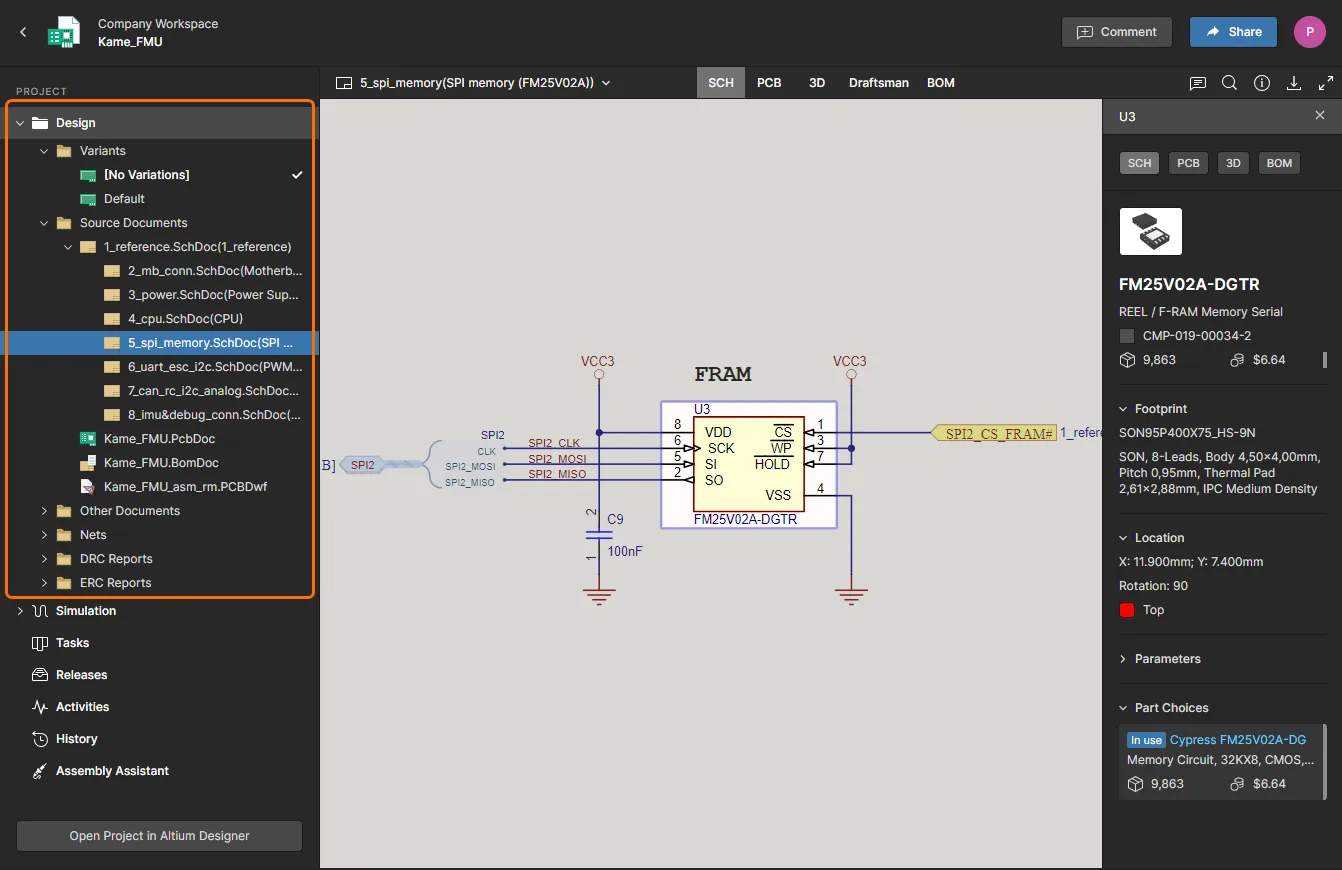
As an independent browser-based viewing platform, the Web Viewer interface offers interactive read-only access to design documents without the need to open the project in the design editing environment. Others that are working on the design, such as the engineer who 'owns' it, will not be affected by actions in the Web Viewer space – except for any related comment notifications, where applicable.
Web Viewer Access
The Web Viewer can be accessed directly in the Enterprise Server Workspace or indirectly from within Altium Designer. In the latter case, the Show in Web Browser menu commands or the Explorer panel's Open in Web button will generate and then open a specific viewer URL in the Workspace's browser interface. That URL can be shared with other users, such as a team manager or librarian for example, allowing them to interact in detail with the current project documents and data via the Workspace Web Viewer interface. All that's required is a Workspace user account and appropriate access privileges.
In the Workspace, the Web Viewer interface is used in the following instances:
-
When viewing the current state (WIP) of a design project source through the Projects Management interface, when managing a specific project.
-
When viewing the design snapshot for a released design package, through the Manufacturing Portal.
The following sections detail how each of these instances is accessed, and how the Web Viewer interface presents in each case.
Viewing WIP Design Project Source Files
In this instance, the Web Viewer interface is presented through the Design view of the opened project page. The latter can be accessed from the Projects page of the Workspace's browser interface by double-clicking on the project entry, single-clicking on the project entry name (when in preview rather than list mode), or by selecting the required project and then choosing the Open option from the  menu above the listing or the
menu above the listing or the  menu associated with the project entry.
menu associated with the project entry.
 Accessing the CAD-centric Projects Management page for a project from the Projects page. The Web Viewer interface is presented through the page's Design view.
Accessing the CAD-centric Projects Management page for a project from the Projects page. The Web Viewer interface is presented through the page's Design view.
Viewing Design Snapshot for a Release Package
In this instance, the Web Viewer interface is presented through the Design Snapshot view of the Manufacturing Portal, for the currently open project release package. To access the portal:
-
From the detailed page of an open project (double-click on the project to access), switch to the Releases view.
-
To open a specific release package for viewing, click on its associated
 button to open the full release package. Alternatively, click the adjoining
button to open the full release package. Alternatively, click the adjoining  button and choose what to view – either the full release package (Full Release) or a specific assembly variant. An opened project release is presented in a new Manufacturing Portal browser tab.
button and choose what to view – either the full release package (Full Release) or a specific assembly variant. An opened project release is presented in a new Manufacturing Portal browser tab.
-
Within the Manufacturing Portal, switch to the Design Snapshot view. Note that you are not viewing the latest version of the source design data, but rather a released snapshot of it, created at the time when this specific manufacture package was released.
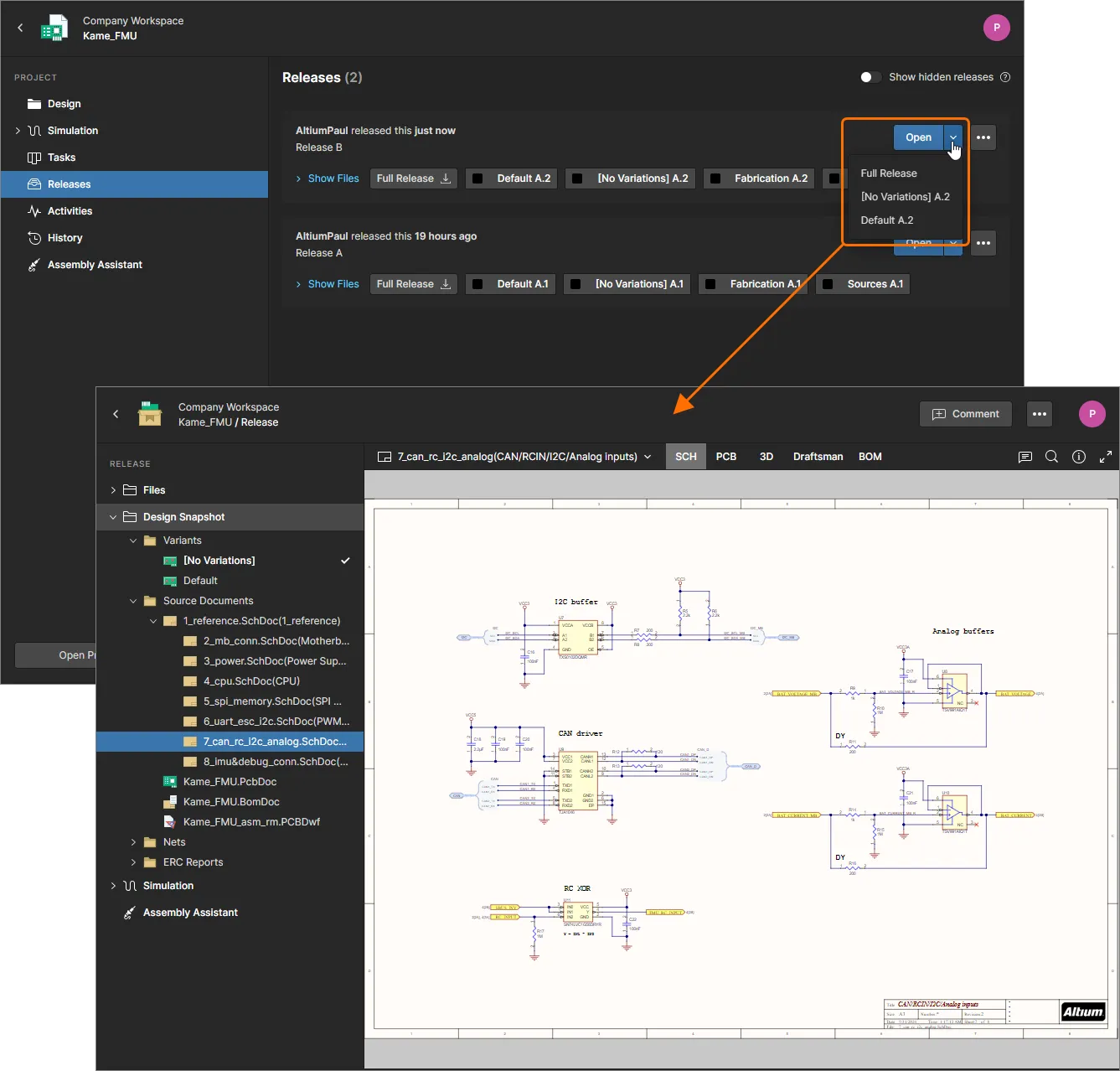
View Released Gerber and PDF Files
The Web Viewer also offers a PDF viewer and a composite view of the Gerber files contained in an opened design Release package.
Activate the Gerber view by selecting any file from the Gerber list within a Fabrication output set. In a similar arrangement to the PCB view, the Layers drop-down menu allows the individual or group selection of Gerber layers for viewing. The Top View or Bottom View Gerber can be selected, and Comments can be placed at any point of the overlay.
Select a PDF file within a released file set to open it in a dedicated PDF viewer. Use the Page dropdown menu (or simply scroll) to move the view to another page in a multi-page PDF document, and the Information pane on the right to access the PDF document metadata.
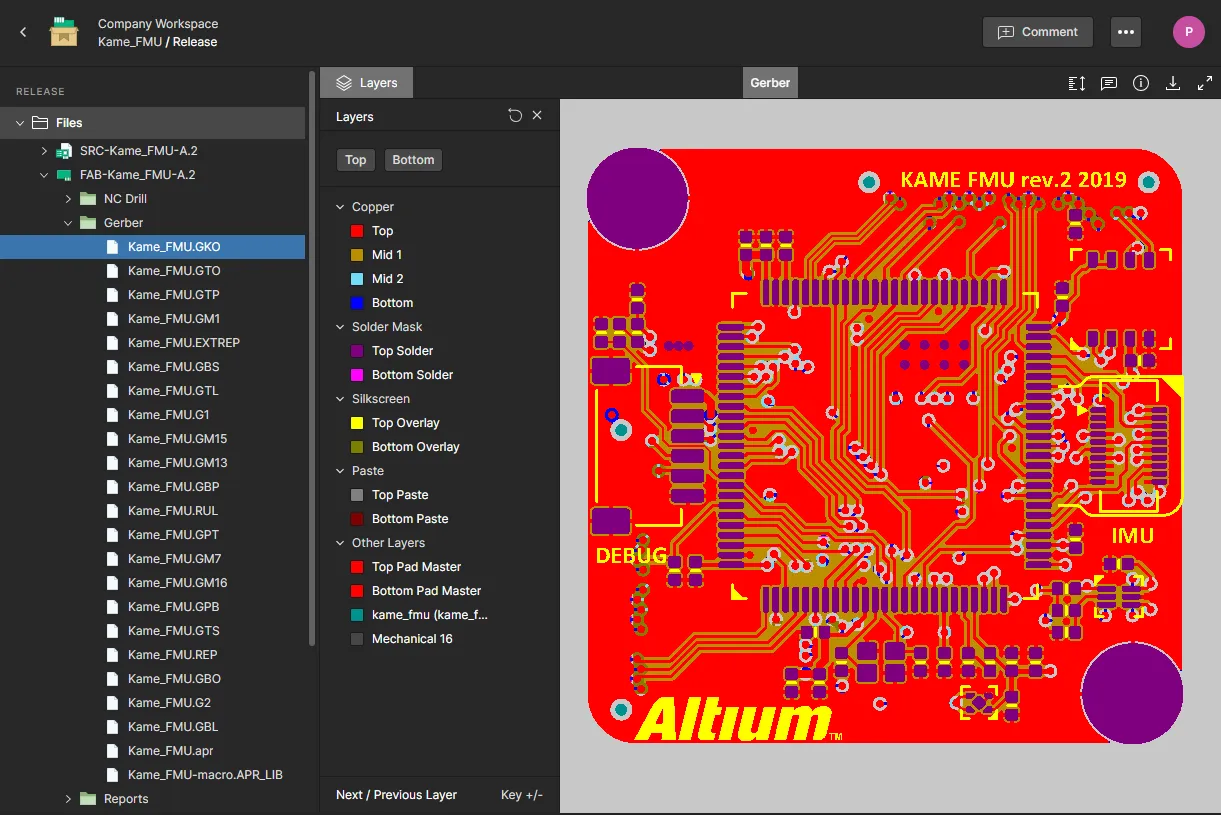
Web Viewer Features
The Web Viewer interface offers a range of integrated capabilities that allow detailed access to design data. Other features such as the Comments system – when used from the Design view of a project – communicate directly, and in real-time, with Altium Designer. The following sections take a look at the superset of functionality available when viewing the design source.
Select the Controls option in the Info pane ( ) to see a list of mouse/keyboard actions available in the data views.
) to see a list of mouse/keyboard actions available in the data views.
Data Views
The Web Viewer interface presents information across distinct data views, to show (when viewing the design source) the source schematics, board in 2D, board in 3D and Bill of Materials respectively.
SCH
This view presents the source schematic sheet(s) for the design.
 The SCH data view presents the currently selected schematic source document.
The SCH data view presents the currently selected schematic source document.
Switching Schematics
If more than one schematic sheet exists for the design, the ability to switch between the documents can be performed in two ways:
-
From the navigation tree in the left-hand pane. Select a schematic entry to make it the active document in the main viewing area.

-
By choosing a schematic entry from the preview drop-down menu, located at the top left of the view. The currently selected document – the active document being viewed within the SCH data view – is distinguished in the list with a blue border around its entry.
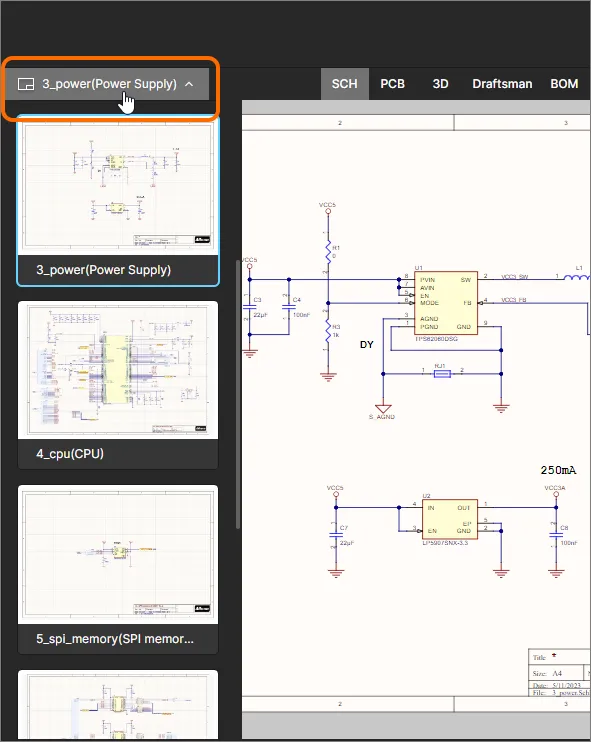
This method of switching between schematics is the only method available when the
Web Viewer interface is placed in
Full Screen mode (by clicking the

control at the top-right of the view).
In-Document Navigation of Project Design Hierarchy
When inspecting a schematic document that is part of a hierarchical design project, the rendered document display itself can provide interactive navigation between the levels in the project structure hierarchy:
-
Click on a sheet symbol object to load the target schematic document.
-
Click on a sheet entry object within a sheet symbol to be taken to the corresponding port on the target child schematic below.
-
Click on a port object to be taken to the corresponding sheet entry of the sheet symbol in the parent schematic above.
Document Navigation by Net
When a Net is selected in the view it is also selected in all schematic documents on which it appears, which are listed in the Information panel on the right. Click on an entry in the list to navigate directly to the selected Net in that document.
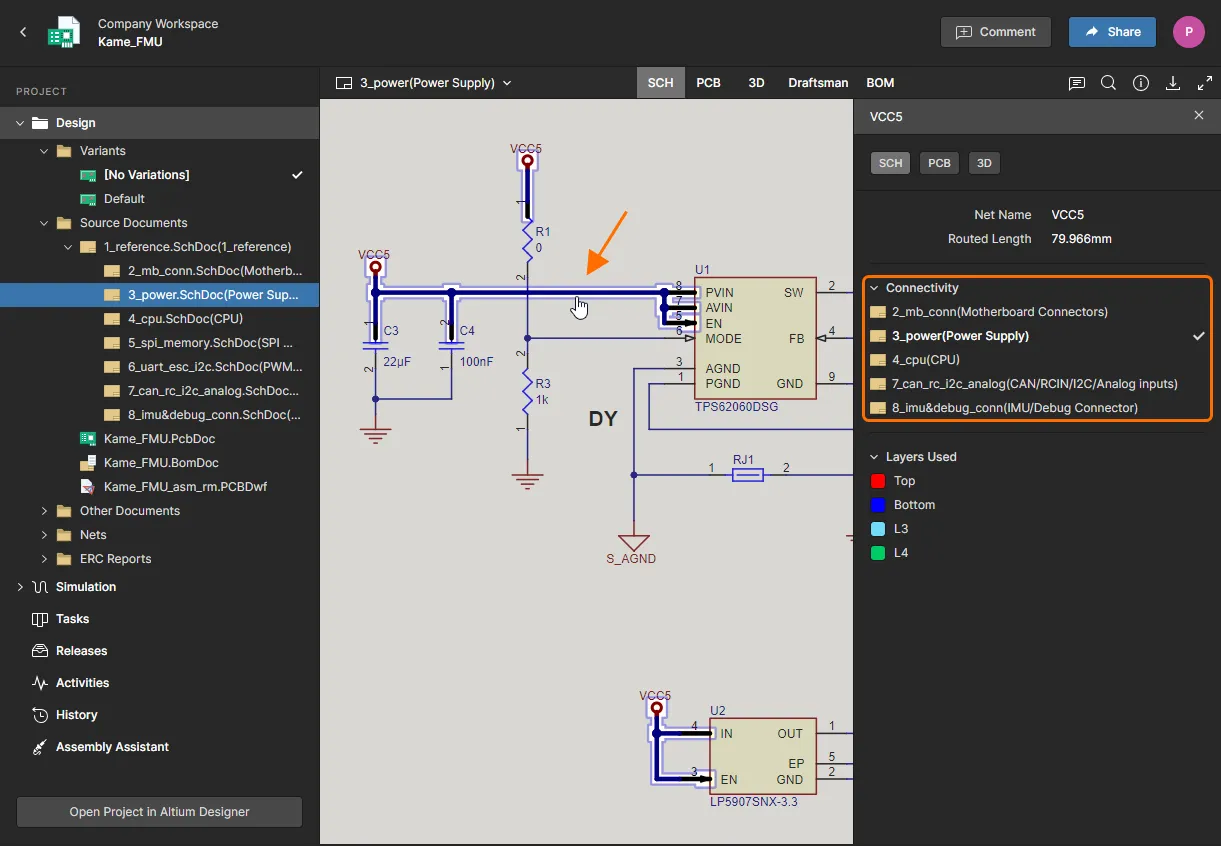
Support for Multi-channel Designs
The Web Viewer supports the viewing of multi-channel designs. A separate schematic document is presented for the logical design sheet and for each physical channel. Physical channel sheets are presented in the left tree on the level under the logical design sheet. The physical sheet name – the compiled tab for that schematic document when viewed through Altium Designer – is included as a suffix to the document name of a physical channel sheet.
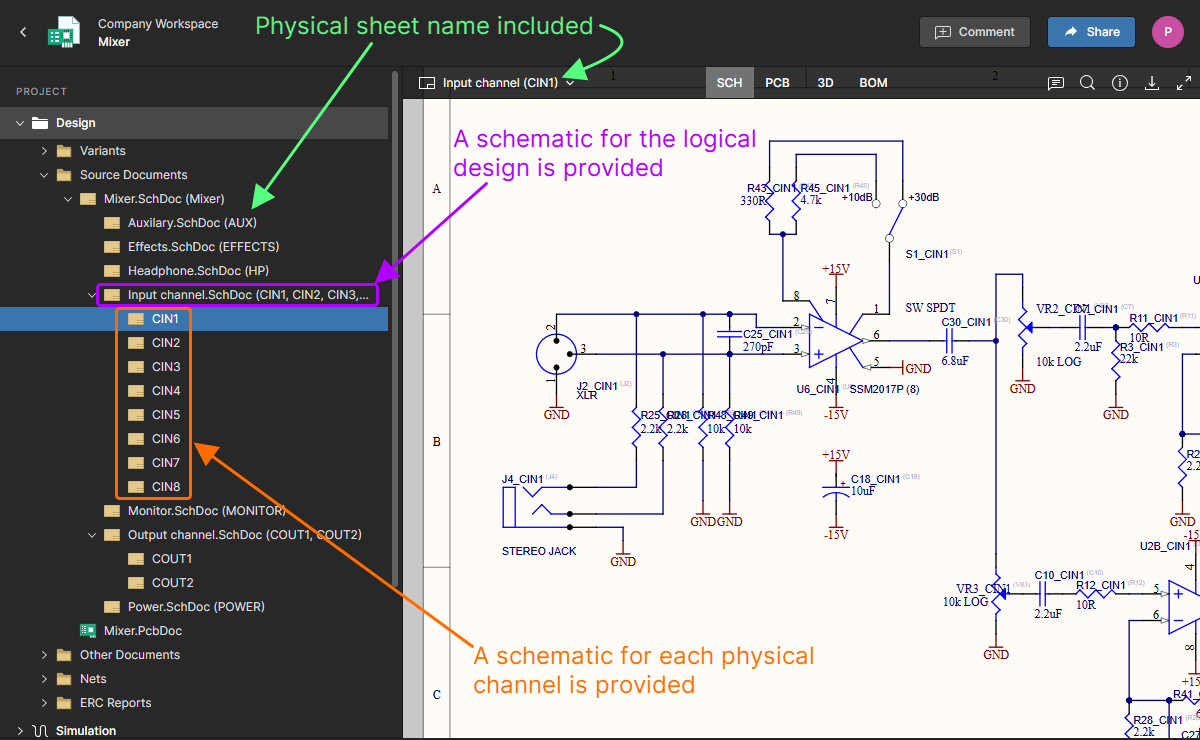
Example multi-channel design, with the logical design and each physical channel being presented on a different schematic sheet.
PCB
This view presents the PCB in 2D.
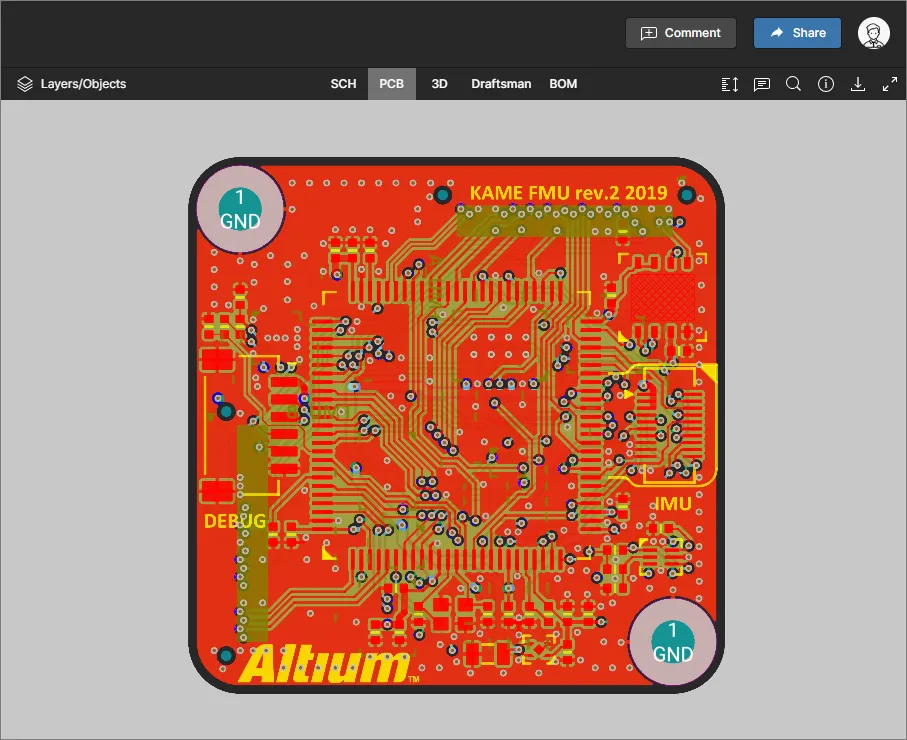
Controlling Layer Visibility
Control over the view and layer visibility for the PCB data view is performed through the Layers mode of the Layers/Objects pane. Access this pane by clicking the  control at the top-left of the view and selecting the Layers view mode.
control at the top-left of the view and selecting the Layers view mode.
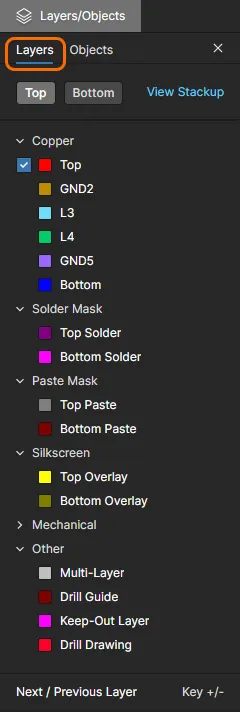 The Layers pane for controlling layer visibility.
The Layers pane for controlling layer visibility.
-
You can pin the Layers pane so that it is always present as you view the PCB in the main viewing area. To do so, click on the
 control (unpinned) at the top-right of the pane – the control will change to
control (unpinned) at the top-right of the pane – the control will change to  (pinned). Click on the control again to unpin.
(pinned). Click on the control again to unpin.
-
The pane also includes access to the board Stackup View.
Each layer entry in the Layers/Objects pane has an associated checkbox that will set it as the active layer. When checked, the layer is set to the top of the draw order and is therefore rendered last so that it effectively overlays the other PCB layer graphics. Uncheck an active layer or use the upper  button to restore the default layer view (
button to restore the default layer view (Top layer active).
A placed Comment will be associated with the currently selected (checked) layer, and that same layer order is restored when the comment is subsequently selected in the Comments pane.
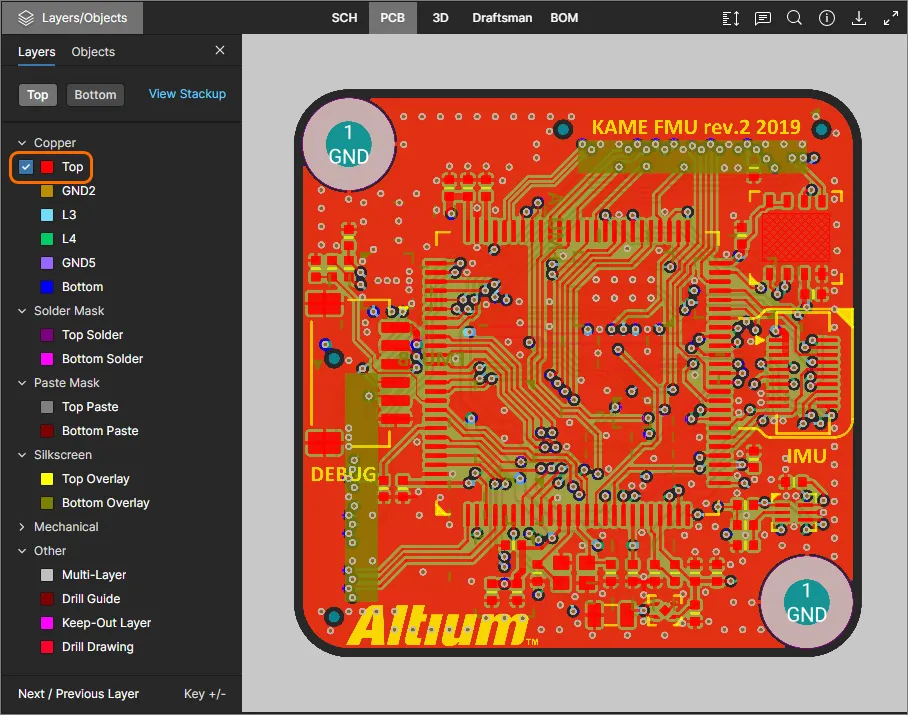
The pane's layer entries are grouped into the following categories:
-
Copper – all used signal and internal plane layers.
-
Solder Mask – Top Solder, Bottom Solder.
-
Paste Mask – Top Paste, Bottom Paste.
-
Silkscreen – Top Overlay, Bottom Overlay.
-
Mechanical – all used mechanical layers.
-
Other – including Mutli-Layer, Drill Guide, Keep-Out Layer and Drill Drawing.
Use the Top and Bottom view controls at the top of the pane to quickly toggle between viewing the board from the top or bottom respectively, and if desired, change the top draw order to suit using the layer entry checkboxes.
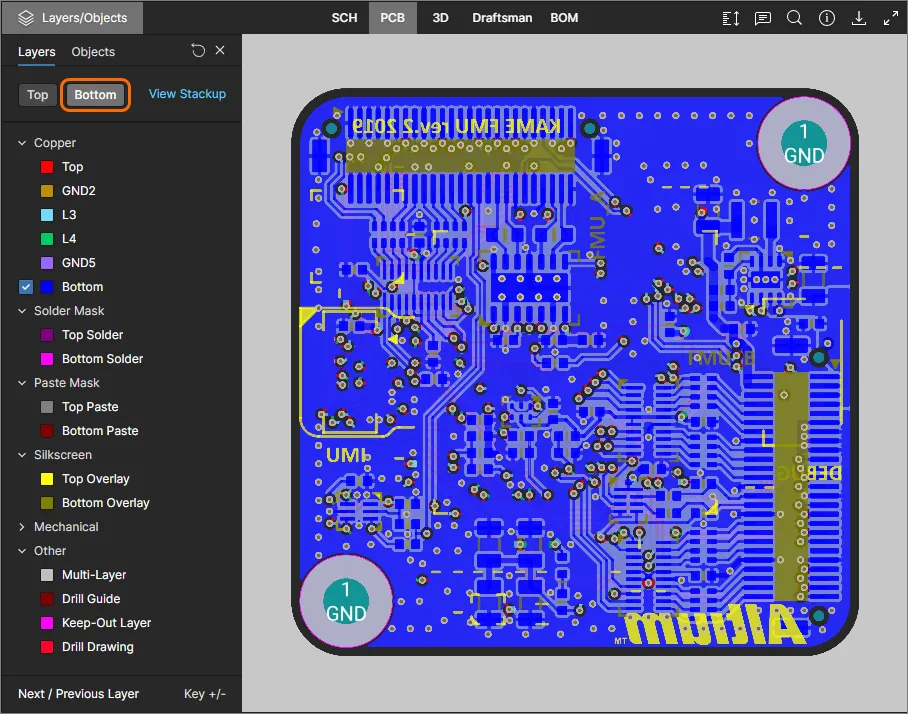 Switch between Top and Bottom views of the board using the provided buttons. Here, the default Top View is shown.
Switch between Top and Bottom views of the board using the provided buttons. Here, the default Top View is shown.
Layer entries in the Layer/Objects pane (in Layers mode) have additional visibility options that are exposed when hovering on the entry. Use the  icon to toggle the visibility of a layer or layer group, the
icon to toggle the visibility of a layer or layer group, the  option to enable only that layer/group (and by default,
option to enable only that layer/group (and by default, Multi-layer objects for copper/mask layers), and the  icon to restore the visibility settings.
icon to restore the visibility settings.
Controlling Object Visibility
Control over the visibility of board objects in the PCB data view is performed through the Layers/Objects pane. Access the objects view options by clicking on the  control at the top-left of the view and then the Objects view option.
control at the top-left of the view and then the Objects view option.
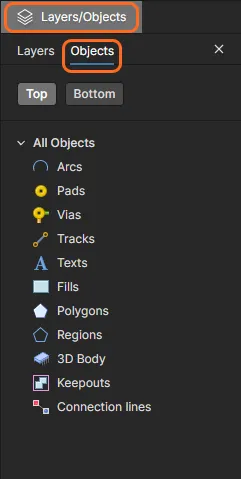 The Layers/Objects pane in the Objects view mode.
The Layers/Objects pane in the Objects view mode.
Select an object type in the list (or on its associated  icon) to toggle its visibility. Multiple object types can be selected. Use the
icon) to toggle its visibility. Multiple object types can be selected. Use the  control to reset the object visibility to its default view – all objects visible.
control to reset the object visibility to its default view – all objects visible.
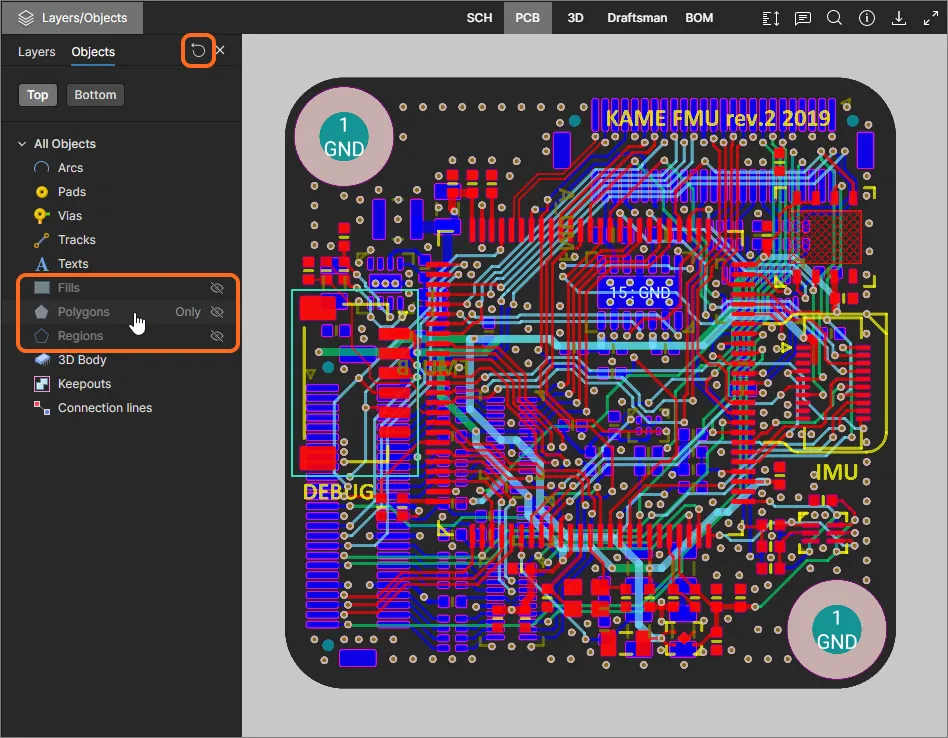 Select one or multiple Object type entrys to toggle their visibility in the PCB view.
Select one or multiple Object type entrys to toggle their visibility in the PCB view.
Note that the view reset control
( )
) for
Objects is independent from the equivalent reset control for
Layers visibility.
Isolate a specific object type for viewing with the Only option associated with its entry. Only that object type will be displayed, with the visibility of all other object types disabled automatically. Use the  control to reset the object visibility to the board's default view.
control to reset the object visibility to the board's default view.
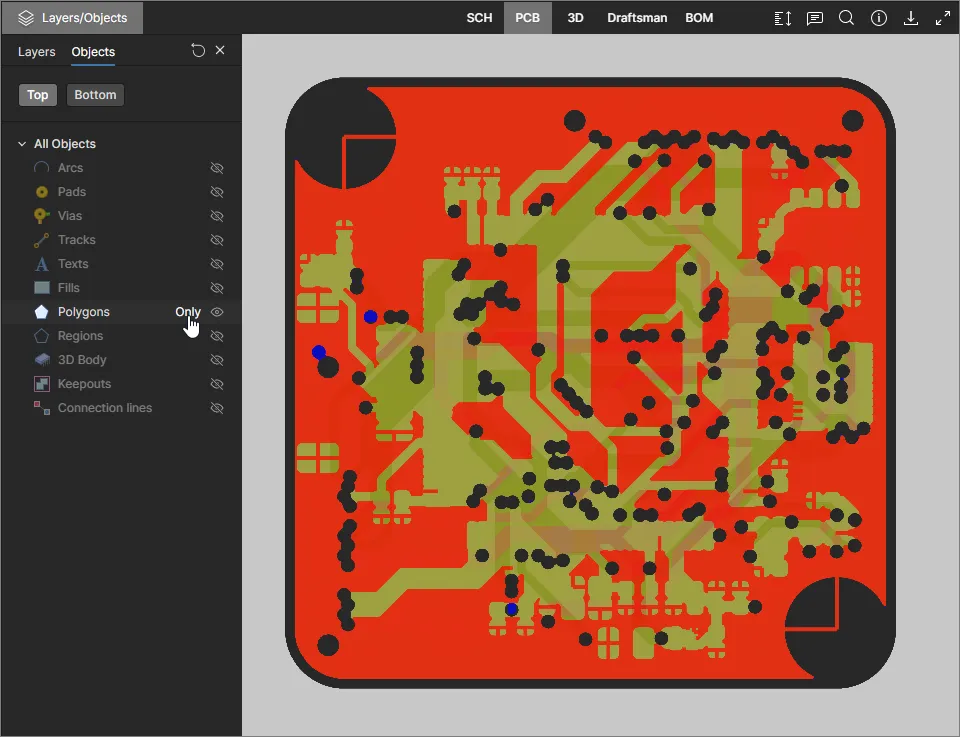 Select of Object enty's Only option to disable the display of all other object types in the PCB view.
Select of Object enty's Only option to disable the display of all other object types in the PCB view.
-
The object visibility options can be used in conjunction with the Layers visibility control and the Top/Bottom view setting to refine the board view to a very specific degree.
-
The Workspace PCB view shows any unrouted nets (the net 'ratslist') as lines, which are displayed by default. These are available for specific selection or isolation in the pane's Objects mode as Connection lines, which provides a simple way to locate unrouted net connectivity – see example
 .
.
Viewing the PCB Layer Stack
A graphical representation of the current design's PCB Layer Stack – the board's physical stack of layers – is available when viewing a WIP design project or an opened Project Release package. The Layer Stackup View presents the board's internal structure along with associated data such as layer types, materials and dimensions.
Open the Layer Stack view by selecting the Stackup View command from the Board Info pane in the project design viewer, or from the Layers menu when a PCB is being viewed. The Layer Stack view is accessed in the same way when viewing the Design Snapshot of a project Release package.
The information pane ( ) is populated with data for the currently selected stack element (Layer, Overlay, Via, etc), or overview data for the board stack when an element is not selected.
) is populated with data for the currently selected stack element (Layer, Overlay, Via, etc), or overview data for the board stack when an element is not selected.
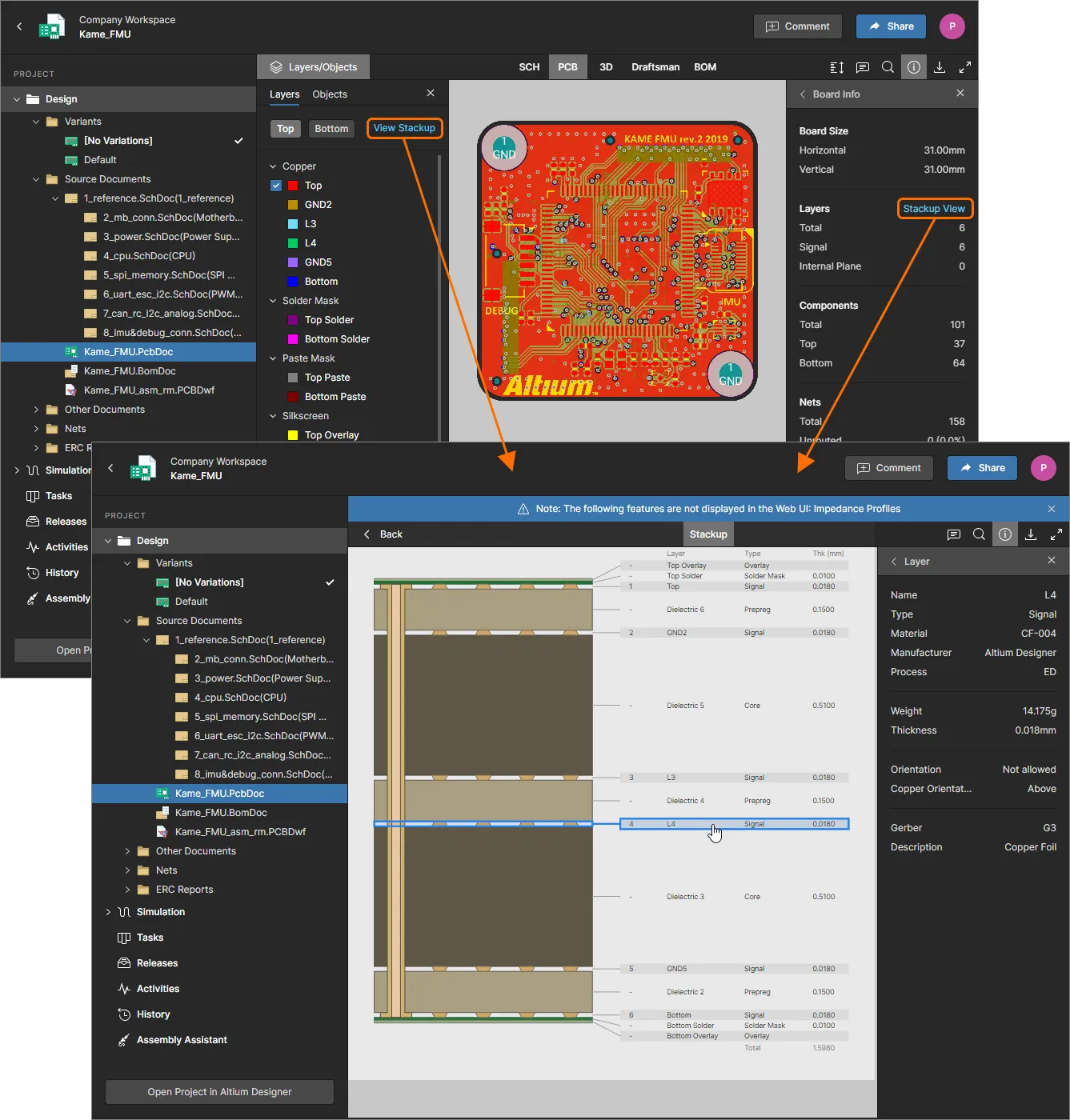
As with other views available in the Web Viewer, Comments can be placed on the Layer Stack view. In this case Comments can be applied to any Layer Stack element (Layer, Via, etc) by selecting its graphical object, and then entering your comment with any user mentions and assignments in the contextual commenting window. Note that Freehand Drawing and Area selection are not available in Layer Stack Commenting.
-
You need to save your design to the Workspace in order to regenerate the Stackup view.
-
At this stage, advanced stackup features such as multiple stacks (rigid-flex), impedance profile and backdrill are not supported.
Viewing Multiple PCB Documents
For those projects that contain additional PCB documents – such as a PCB panel, a prototype version of the board layout, or a separate PCB design (and corresponding schematic document) – the Web Viewer supports display and cross-probing capabilities for these 'non-primary' PCB documents.
When such as PCB document is opened for viewing, the Web Viewer's associated features will relate to the selected board layout wherever possible, and otherwise default to the primary PCB (the first one found in the project structure). Placed Comments will be associated with the board layout, and features such as Net navigation, layer Stackup View, measurements, and Information pane data will all apply to the opened additional PCB document.
The primary PCB is the first found (highest) in the project structure order, which is in turn determined by the order arranged in Altium Designer. In Altium Designer's Projects panel, drag and drop PCB documents to different project structure positions to set the related priority order.
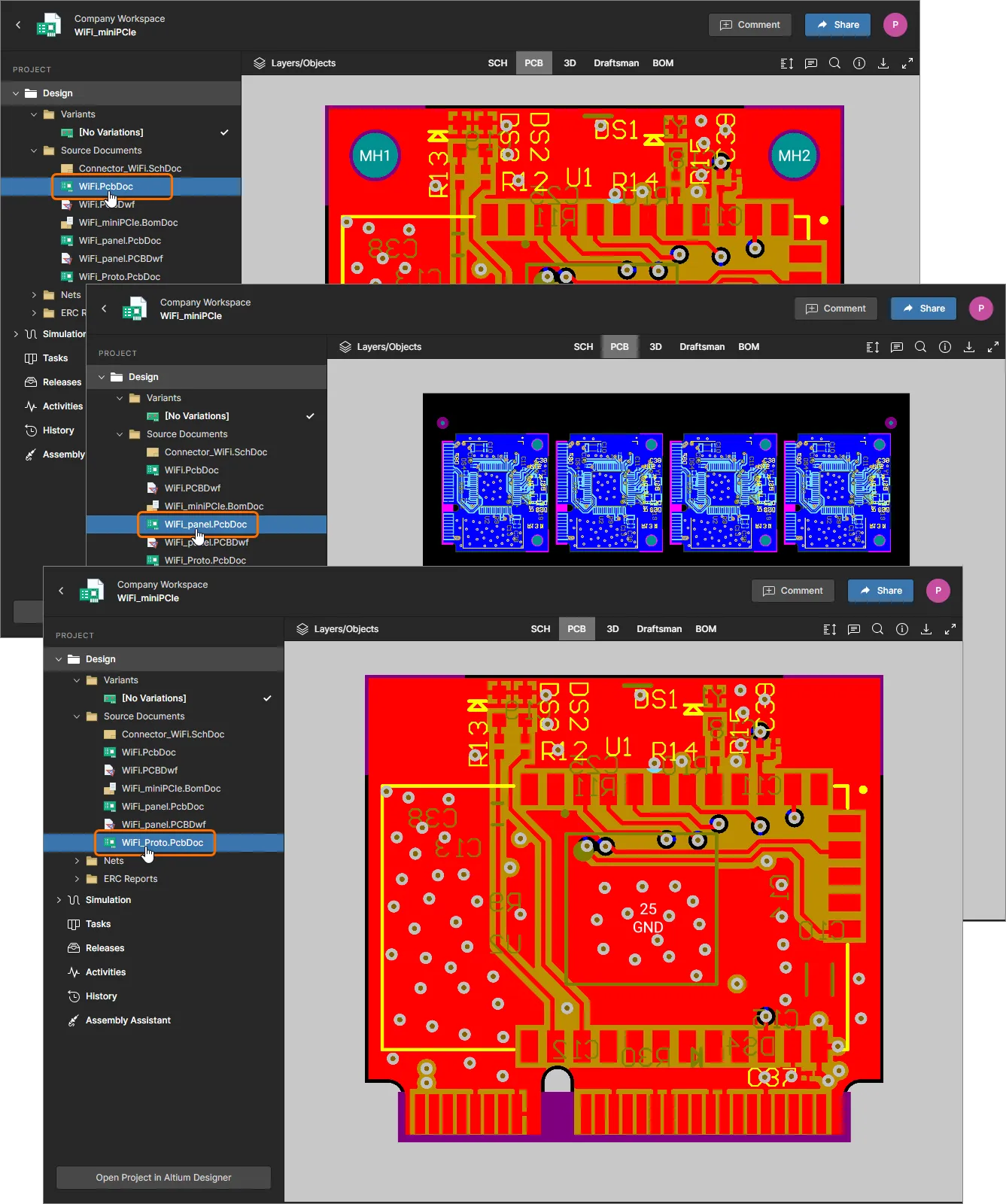 By default, the first (highest in the order) PCB is shown. Select another PCB document to access that board design and its associated Web Viewer features.
By default, the first (highest in the order) PCB is shown. Select another PCB document to access that board design and its associated Web Viewer features.
The Web Viewer's features such as PCB Measurement, placed Comments and object Search are all available for additional PCB documents. If a selected search object or comment applies to a different PCB document, the comment/object is automatically selected and highlighted in its associated PCB document, as shown below.
The Web Viewers features are available for, and associated with, each PCB document.
Cross-probing between the main design views is supported for additional PCB documents where possible:
-
If a single Schematic document relates to two PCBs, say with different physical layouts, cross-probing from that schematic will target the project's primary (first) PCB document.
-
In the above case, cross-probing from either PCB will open the common Schematic document.
-
Where an additional PCB has its own related Schematic document, cross-probing will be directly between these two documents.
-
BOM data, Layer Stackup, and Simulation uploads relate to the overall project design.
❯ ❮
Javascript ID: AES_AdditionalPCB_Crossprobe_7_0
|
Taking Measurements
When viewing the board in 2D – using the PCB data view – you are able to take measurements using the  button. This opens the Measurements pane, the cursor changes to a cross-hair and enters measurement mode. Three measurement modes are supported:
button. This opens the Measurements pane, the cursor changes to a cross-hair and enters measurement mode. Three measurement modes are supported:
-
Free – freely measure between any two points within the data view, without any snapping guidance whatsoever.
-
Point to Point – measure between any two points within the data view, with guidance snapping as you move the cursor over an object. The cursor will change as follows:
-
 – the center of a pad or via.
– the center of a pad or via.
-
 – the vertex point of a primitive object.
– the vertex point of a primitive object.
-
 – the mid-point of a track segment.
– the mid-point of a track segment.
-
 – a free point within the view.
– a free point within the view.
-
Object to Object – measure between any two chosen objects within the data view. Supported objects are pad, via, track, fill and region, which will become highlighted for selection as you move the cursor over them.
Switch modes using the selectors at the top of the pane. When accessing the feature for the first time, the Free mode will be used by default. Subsequent use of the feature will use the mode last used.
Measurement is performed as follows:
-
In Free or Point to Point modes, position the cursor to where you wish to start measuring (Point 1) and click. The point is marked using a small white cross. In Object to Object mode, choose the first object (Object 1), which will become selected.
-
In Free or Point to Point modes, move the cursor to the required end point (Point 2) and click again. As you move the cursor, a measuring line is displayed as an aide, showing the current XY distance (from Point 1 to the end of the line). In Object to Object mode, choose the second object (Object 2), which will become selected.
Right-click before defining Point 2/Object 2 to start afresh – ready to define Point 1/Object 1 again.
-
The Measurements pane reports the XY distance measured, the X (horizontal) distance, and the Y (vertical) distance. For the Object to Object mode, the XY distance will be the shortest point between the two chosen objects.
Measurement units will initially be those used for the design itself, but can be switched between metric (mm) and imperial (mil) from the
Info pane of the interface (accessed by clicking

in the top-right control cluster).
-
Continue measuring the distance between other points or objects, or click the
 button again (or Esc) to exit measurement mode.
button again (or Esc) to exit measurement mode.
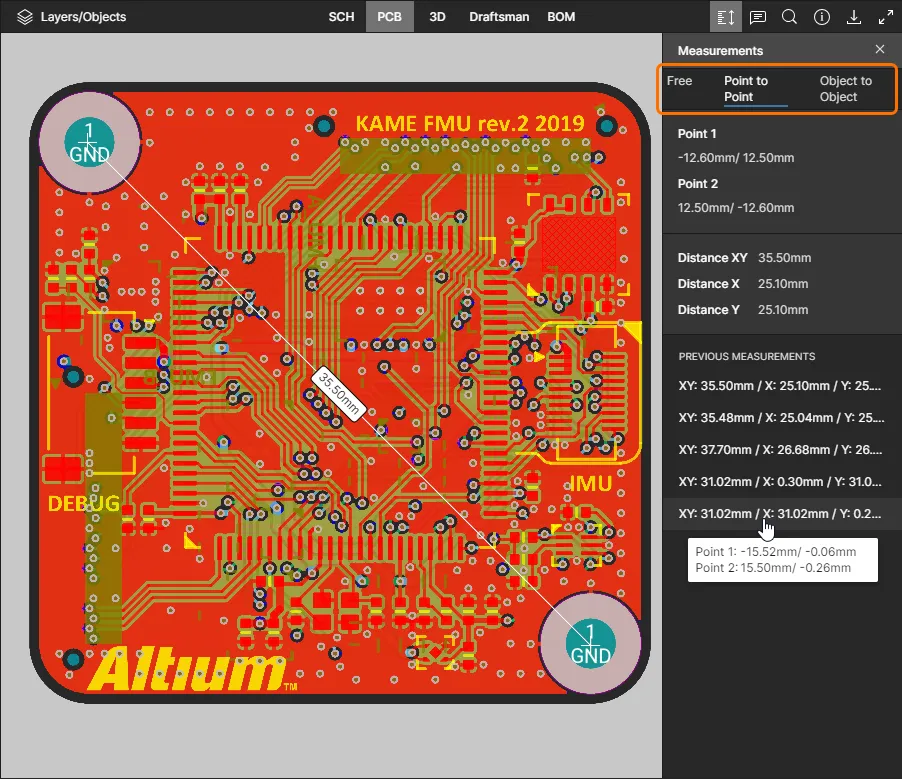 Example measurement taken in Point to Point mode.
Example measurement taken in Point to Point mode.
The last five measurements are listed in the Previous Measurements region of the Measurements pane. The most recent is at the top of the list. Click on an entry to retrieve that measurement – both in the pane and graphically in the main viewing area.
Measurements are available during the current session of the browser page only. If you refresh the browser tab, the previous measurements will be cleared.
3D
This view presents the PCB in 3D.
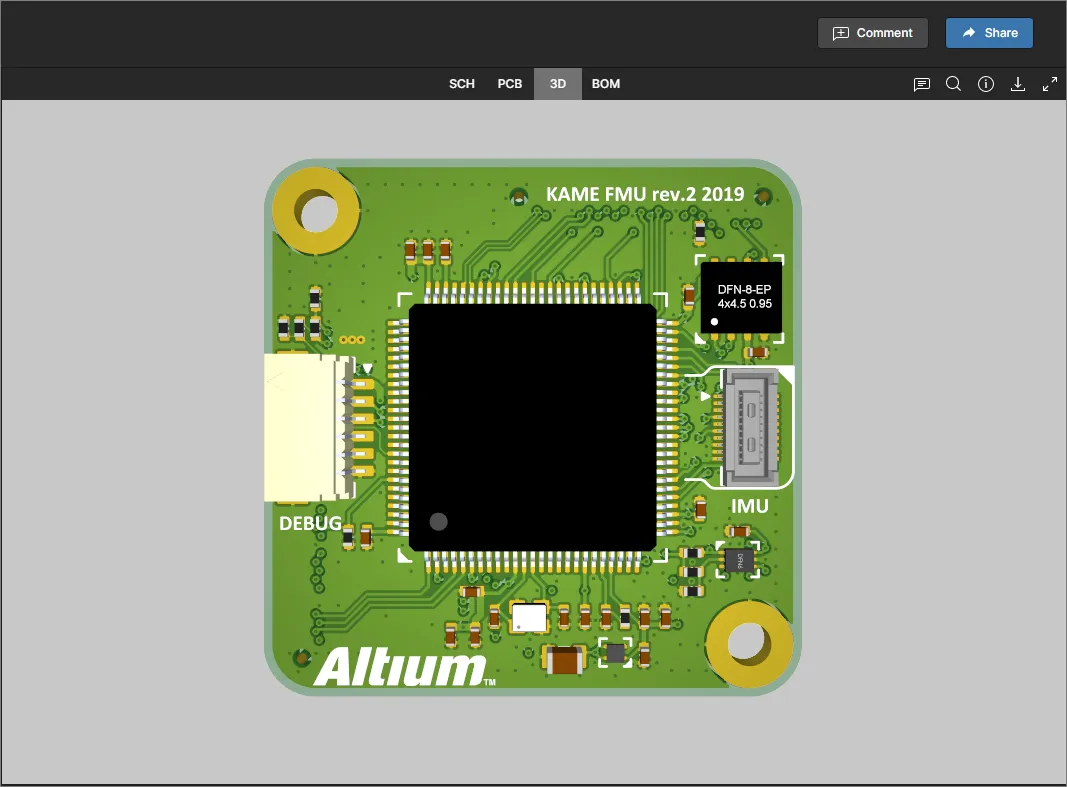 The 3D data view presents a 3D view of the PCB.
The 3D data view presents a 3D view of the PCB.
Draftsman
This view presents the Draftsman documents available in the design. A Draftsman document also can be opened for viewing by selecting a Draftsman document (*.PCBDwf) from the Navigation tree on the left, and as with other design views, the Draftsman view supports document Commenting.
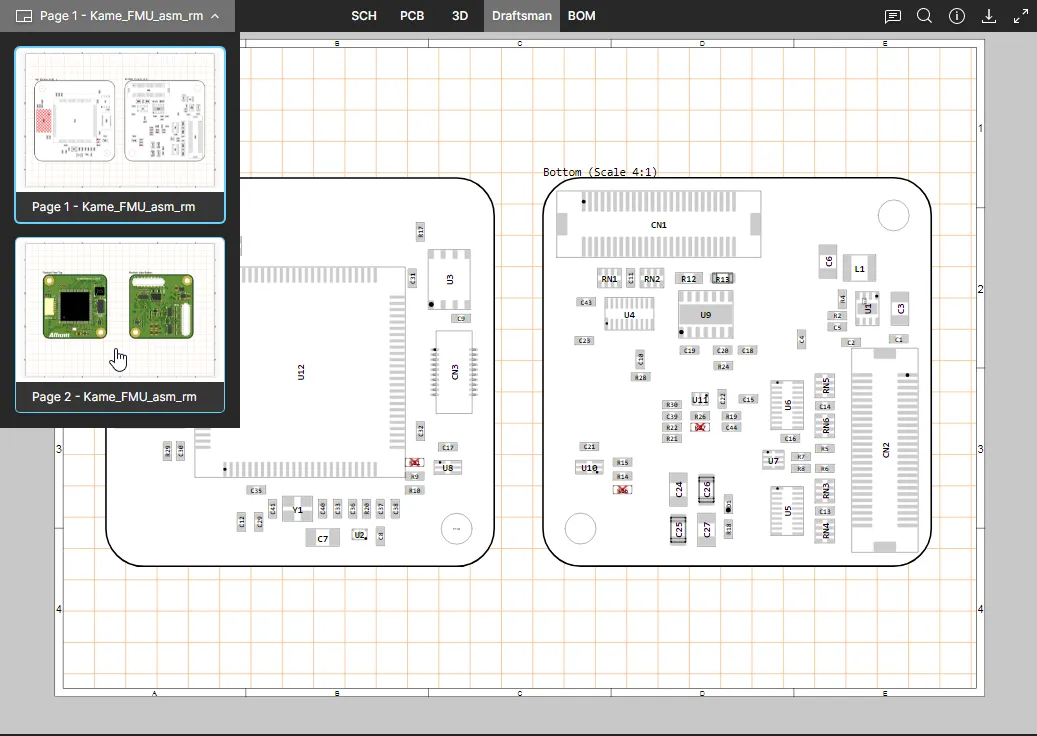 The Draftsman data view presents all pages of the currently selected Draftsman source document.
The Draftsman data view presents all pages of the currently selected Draftsman source document.
Switching Draftsman Documents
The viewer initially will show the first available Draftsman document in the Source Documents hierarchy. Open another Draftsman document by selecting its entry from the navigation tree in the left-hand pane.
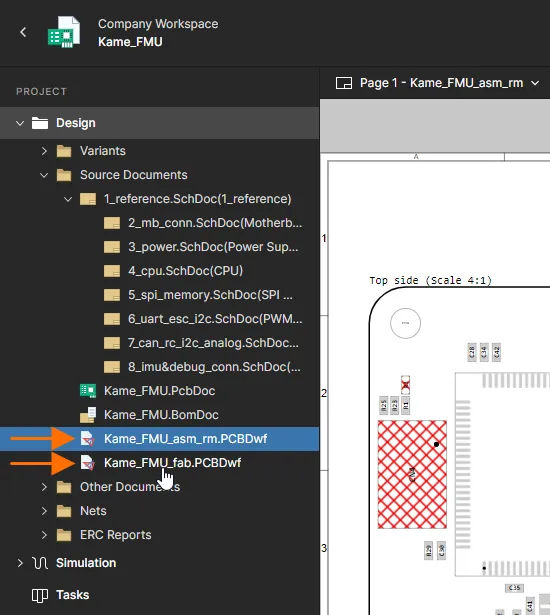
Navigating Draftsman Pages
The individual pages of a multipage Draftsman document are available for selection from the Page drop-down preview menu.
BOM
This view presents the Bill of Materials for the design. This is built on-the-fly from the source schematic documents, or from an ActiveBOM document (*.BomDoc) if one is included in the project. The view is both interactive and configurable, and incorporates current component data derived from Altium's supply chain resources.
❯ ❮
Javascript ID: AES_DataView_BOM_Generated_7_0
|
The BOM data view presents the Bill of Materials for the design.
Select an entry row to see its details in the Information pane.
|
The BOM reflects all components required to assemble a single board and also actively checks the validity of the current data, which is indicated through status icons – for example;  clear/OK,
clear/OK,  duplicated component value,
duplicated component value,  obsolete part or insufficient stock. Hover over the icon to view its status. Pricing information is sourced through Altium parts provider services, which also provide web links to component part and supplier data.
obsolete part or insufficient stock. Hover over the icon to view its status. Pricing information is sourced through Altium parts provider services, which also provide web links to component part and supplier data.
The following points relate to working with the view:
-
Click on a component Manufacturer Part Number entry to access a web link to the corresponding real-world manufacturer part.
-
Click on a component Supplier Part Number entry to access a direct web link to the supplier's part information.
-
Click on a designator to cross-probe to that component in the other data views.
-
You can sort the entries by a column by toggling its header between ascending (
 ) and descending (
) and descending ( ) order.
) order.
-
Drag the junction between headers to resize the column width.
-
Use the columns settings menu ( ) to specify which columns are displayed in the view – the options are derived from all parameters present in the BOM components.
) to specify which columns are displayed in the view – the options are derived from all parameters present in the BOM components.
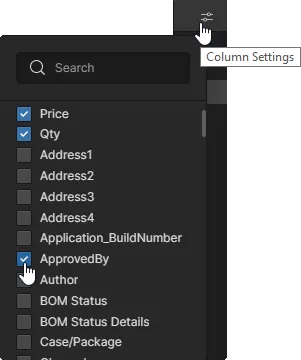
-
A Comment added to a line entry in the BOM data view is marked by an icon at the beginning of the line, which when selected, will open the related Comment in the commenting window.
❯ ❮
Javascript ID: AES_DataView_BOM_Comments
|
-
Use the Search field above the listing (
 ) to quickly find a component of interest.
) to quickly find a component of interest.
-
You can perform BOM data comparisons from a project's Releases or History views. See BOM Comparison for more information.
When an ActiveBOM document is included in the project the BOM view will adopt its settings, such as custom columns, column aliases, defined validation checks, line numbers, etc.
See BOM Management with ActiveBOM for more information on creating and configuring an ActiveBOM document.
Multi-board Design View
This view presents Schematic and 3D views configured for Multi-board project documents. The high-level Multi-board Schematic (MBS) and Assembly (MBA) documents provide data that represent the electrical and physical connectivity information between Multi-board 'child' projects – the sub-projects that collectively make up a Multi-board project.
The Multi-board Design data view is invoked when a Multi-board project is opened from the Workspace's main Projects view. It includes tabbed view options for schematic (MBS), board assembly (MBA) and collated BOM views, which present the design from the Multi-board perspective of interconnected child projects. Select the Child Projects option from the navigation tree to view and access the Multi-board project's constituent (sub) projects.
❯ ❮
Javascript ID: AES_WebViewer_MB_7_0
|
The Web Viewer's Multi-board design view offers detailed graphical and data access to Multi-board Schematic, Assembly and BOM views.
The Web Viewer's Multi-board design view offers detailed graphical and data access to Multi-board Schematic, Assembly and BOM views.
The Web Viewer's Multi-board design view offers detailed graphical and data access to Multi-board Schematic, Assembly and BOM views.
|
MBS Information Pane
Click on any Module or Entry Point in the MBS schematic to view its details in the Information pane on the right. Click the  icon to open the Comments and Tasks pane and place a comment note on a Module, Entry Point, or in free space – see the below Comments section for more information.
icon to open the Comments and Tasks pane and place a comment note on a Module, Entry Point, or in free space – see the below Comments section for more information.
❯ ❮
Javascript ID: AES_WebViewer_MB_MBS_Info_7_0
|
MBA Objects Pane
-
The Multi-board Projects view includes individual project designs that are incorporated within the Multi-board project (its sub-modules). Each of the included sub-projects can be opened individually as normal. See Viewing Multi-board Projects.
-
The Multi-board Tasks and Releases views apply the Multi-board's sub-projects, whereas the History view presents
Commit events that apply to the Multi-board project itself.
-
Multi-board projects may be shared with other Workspace members. See Sharing a Multi-board Project.
Harness Design View
This view presents the fundamental wiring and layout views for Harness Design project documents. The specialized Harness Wiring Diagram (*.WirDoc) and Harness Layout Drawing (*.LdrDoc) documents provide data that represent the wires/cables between connectors, and the physical construction of that harness. Harness projects also can include Draftsman documents for additional information, and an ActiveBOM document that details the required harness parts. Note that a Harness project can be integrated with a Multi-board project to represent its existing harness-type connections.
See Harness Design in Altium Designer for detailed information on creating Harness Designs.
A Harness Design project is opened from the Workspace Projects page. The view includes selectable tabs for each included document type (Wiring, Layout, Draftsman, and BOM).
❯ ❮
Javascript ID: AES_WebViewer_Harness_7_0
|
Details of a selected object in the main wiring/layout views are presented in the Information pane on the right.
Harness Information Pane
Click on a Component, Wire, Cable, Splice, Bundle, object in the Wiring/Layout views to inspect its details in the Information pane on the right. Component information includes its name/description, associated parameters, connection pins, and any assigned socket cavities. Basic color/gauge data is shown for harness wires, and included objects (components and wires) and parameters are listed for harness wiring bundles.
❯ ❮
Javascript ID: AES_WebViewer_Harness_Info_7_0
|
Other Documents
Other types of document files that have been stored in the source Altium Designer project are collectively made available in the Workspace Design view’s Other Documents location. These ‘non-CAD’ files (typically design specifications, reference material, status logs, and so on) are hosted under version control along with the core design files. A selected file is available for download from its associated  icon or from the main view area – the exception is PDF files, which are opened automatically in the Workspace PDF viewer.
icon or from the main view area – the exception is PDF files, which are opened automatically in the Workspace PDF viewer.
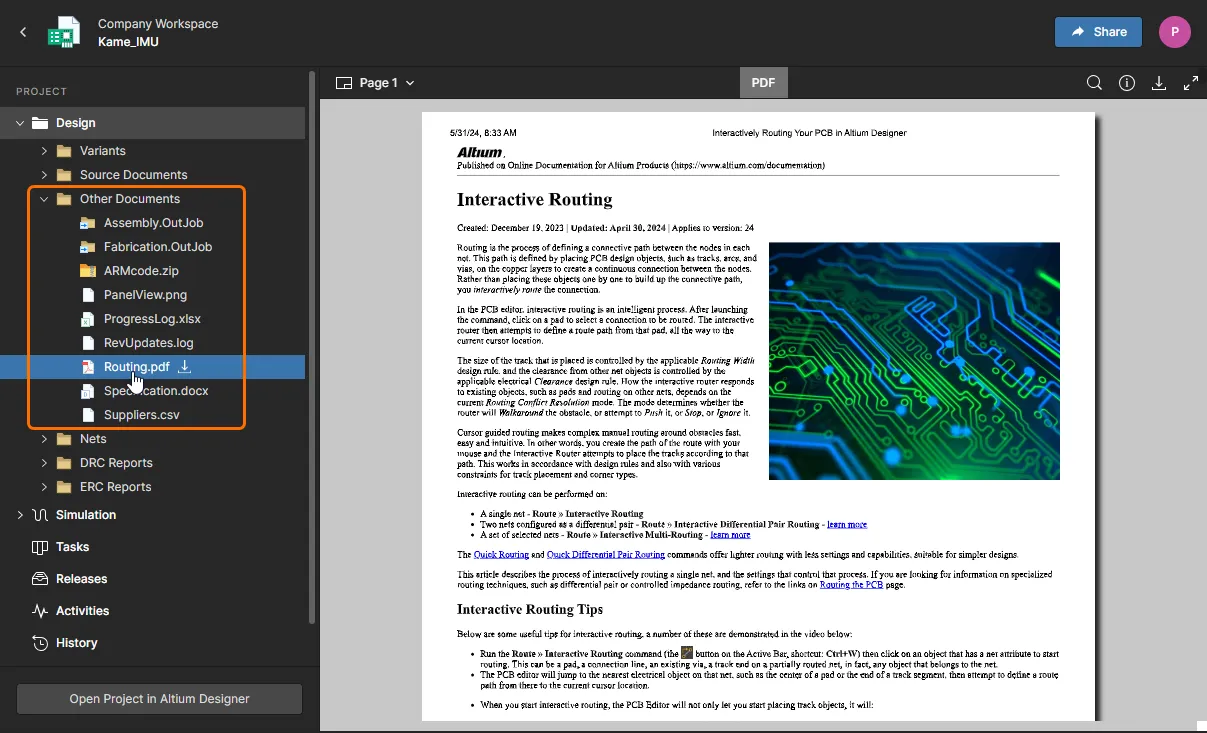
The Web Viewer includes 'non-CAD' files under the Other Documents header. Re-save the project from Altium Designer if they cannot be seen.
DRC and ERC Reports
The Web Viewer includes both Design and Electrical Rule check (DRC and ERC) reports for the current project, which are generated from the source design data in compliance with the settings specified by Altium Designer – as stored in the project documents. This provides convenient access to rule errors or violations for review purposes without the need to access the design in Altium Designer.
These are available as expandable lists within the Project navigation pane's Design section. The reports are dynamically generated as required, such as when the project has been updated and resaved to the Workspace from Altium Designer. Note that a DRC or ERC report is included only when related errors have been detected.
 Both Design and Electrical rule checks are generated by the Enterprise Server for review purposes, when applicable.
Both Design and Electrical rule checks are generated by the Enterprise Server for review purposes, when applicable.
For more information on Design and Electrical rules and their settings, see:
Expand a DRC or ERC report to expose its included category types, each of which will open a sub-list of the specific violations or Error/Warning/etc that have been detected. A DRC violation that has been waived in Altium Designer is indicated by a  icon associated with its entry.
icon associated with its entry.
When selected, a specific entry will open the related document and zoom/pan to the relevant area. The Report information pane on the right will include full details of the selected entry, including the rule information, class and type, and also the specific objects that are affected.
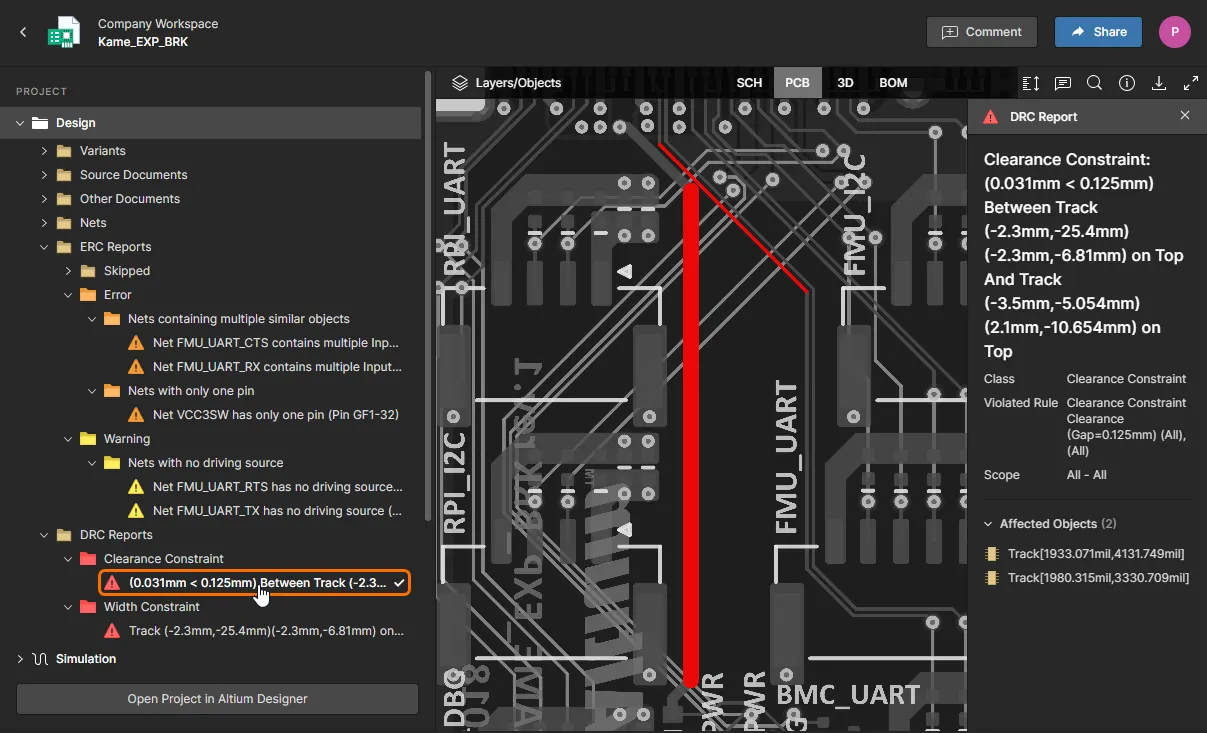
When selected, the rule violation/error entries will present their detailed information and cross-probe to the related document and location.
Note that, initially, you may need to re-save the project from Altium Design to the Workspace (Save to Server) to invoke the DRC/ERC generation process.
Common Interface Elements
The following controls are common to all data views:
-
 – use this control (located in the top-right control cluster) to access the Search facility, allowing you to search for components and/or nets. This facility is available for the SCH, PCB and 3D data views, while BOM has its own text-based search. For more information on using the search facility, see Searching.
– use this control (located in the top-right control cluster) to access the Search facility, allowing you to search for components and/or nets. This facility is available for the SCH, PCB and 3D data views, while BOM has its own text-based search. For more information on using the search facility, see Searching.
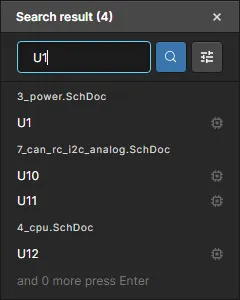
-
 – use this control (located in the top-right control cluster) to access the Info pane.
– use this control (located in the top-right control cluster) to access the Info pane.

The pane is further divided into two sub-views:
-
Controls – gives a helpful listing of controls when browsing the SCH, PCB and 3D data views (some controls are view-specific).
-
Board Info – gives useful summary information about the uploaded design in terms of:
-
Board Size – X and Y dimensions of the board.
-
Layers – Total Signal + Plane as well as counts for each. Also included is access to the board Stackup View.
-
Components – Total, including all types of component, with a breakdown of those components on Top and Bottom of the board.
-
Nets – Total, along with the number and overall percentage of any unrouted nets, with associated links to those nets (see example
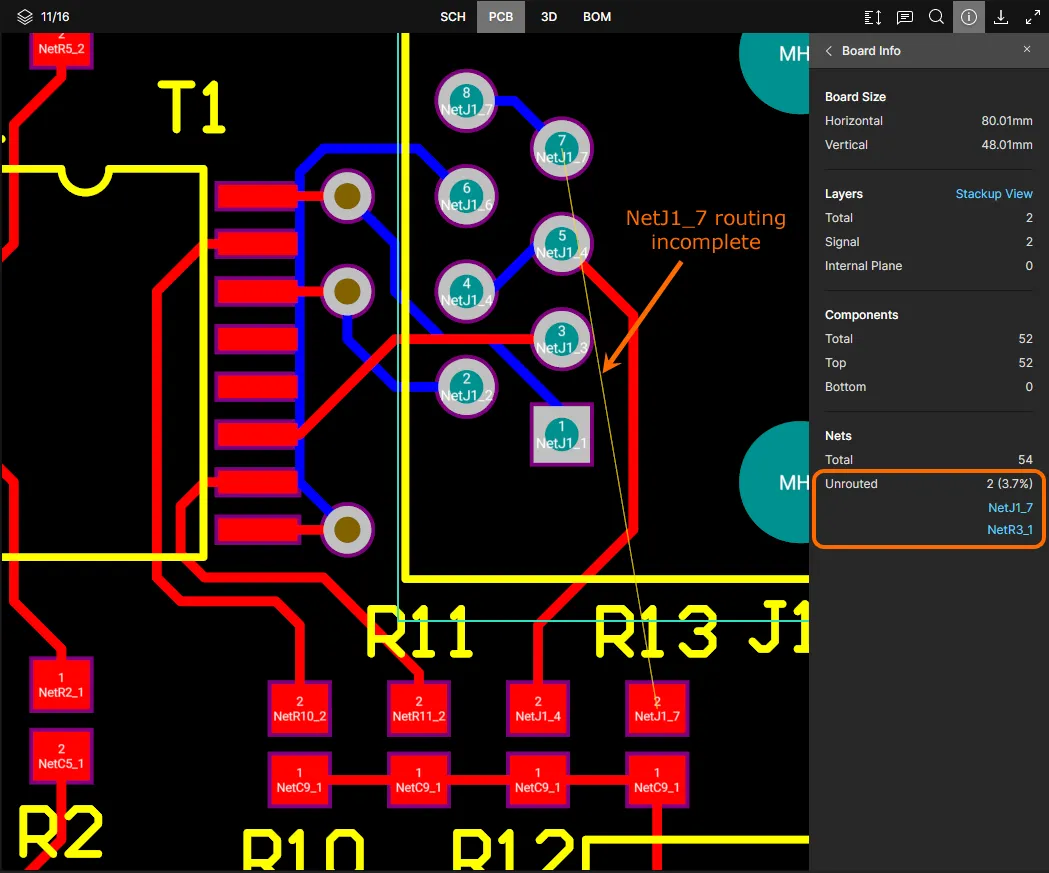 ).
).
At the bottom of the pane, use the available controls to switch Units between metric (mm) and imperial (mil). Measurement units will initially be those used for the design itself.
-
 – use this control to download data. For more information on what is, or can be downloaded, see Downloading.
– use this control to download data. For more information on what is, or can be downloaded, see Downloading.
-
 – use this control (located in the top-right control cluster) to switch to Full Screen mode.
– use this control (located in the top-right control cluster) to switch to Full Screen mode.
-
 – when in Full Screen mode, use this control (located in the top-right control cluster) to exit Full Screen mode (or press Esc).
– when in Full Screen mode, use this control (located in the top-right control cluster) to exit Full Screen mode (or press Esc).
Variant Support
If the project includes defined variants, then you will be able to switch between these when viewing the design across the various data views. The left-hand navigation pane presents a listing of the available variants. By default, this will be set to [No Variations] – presenting the base design.
Choose a defined variant from the list of all variants defined for the project – the current data view will update to reflect that variant, including the visual options enabled for not fitted components (SCH and PCB data views).
![By default, the base design ([No Variations]) will be presented (shown here in the SCH data view). Use the controls in the left-hand navigation pane to switch to a different variant. By default, the base design ([No Variations]) will be presented (shown here in the SCH data view). Use the controls in the left-hand navigation pane to switch to a different variant.](https://files.doc.altium.com/sites/default/files/wiki_attachments/324715/AES_DataView_SCH_VariantSelection1_7_0.webp?VersionId=gozCxdikV3hS8_p8DaGYHPrKAAgYJ_HR)
By default, the base design ([No Variations]) will be presented (shown here in the SCH data view). Use the controls in the left-hand navigation pane to switch to a different variant.
In the 3D and BOM data views, the component will be present/listed depending on whether it is fitted or not.

Selection
Selection of an object within the design can be performed from the SCH, PCB and 3D data views as follows:
-
From the SCH data view (component and net selection) – hover the cursor over a component or wire and click to select. Masking is applied to leave only that component or net fully visible. Information for the selected component/net will appear in the right-hand pane.
-
Potential objects for selection – components and wires – are highlighted as you move the cursor.
-
A selected net will be selected across all schematic documents on which it appears.
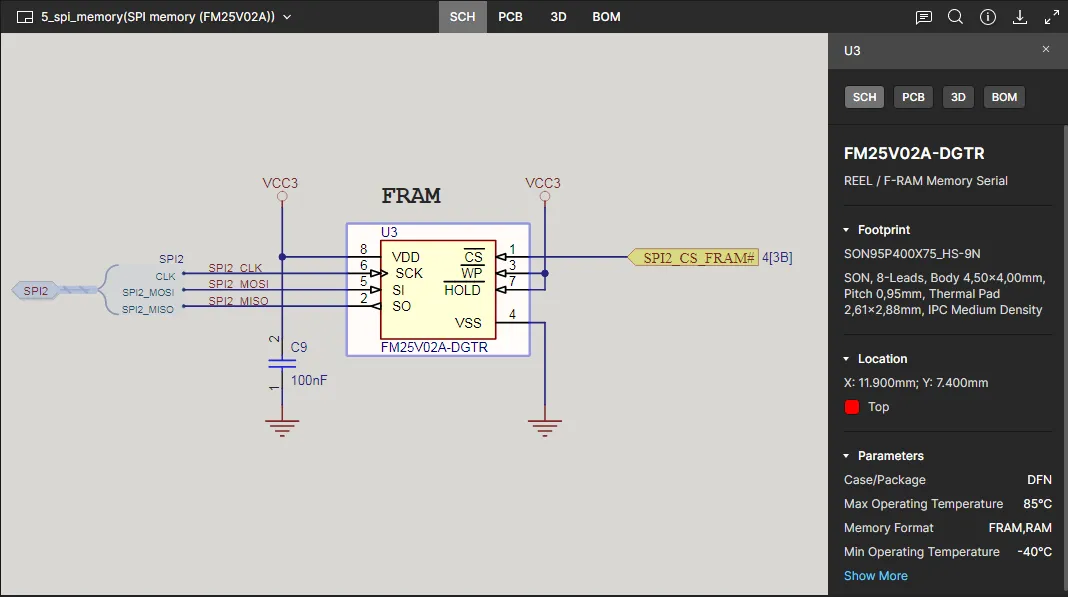 The SCH data view supports the selection of components and nets. Here, a selected component is shown.
The SCH data view supports the selection of components and nets. Here, a selected component is shown.
-
From the PCB data view (component, pad, via, track segment and net selection), hover the cursor over a supported object type and click to select. Masking is applied to leave only that object fully visible. Information for the selected object will appear in the right-hand pane – for a pad, via or individual track, a link to its connected net is available (see example
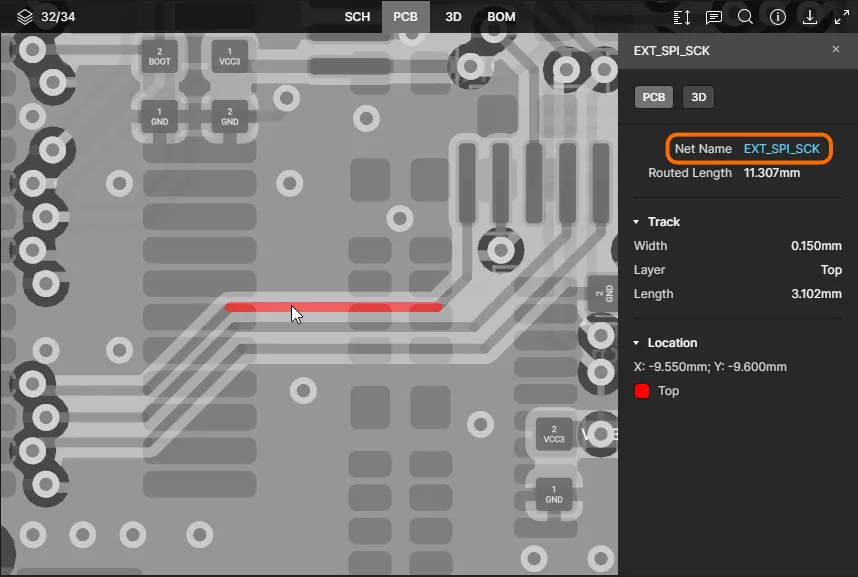 ).
).
-
Only components are highlighted as you move the cursor. Only an individual component, pad, via, track segment, or net can be selected (no cumulative selection). For a selected pad, via, or track segment, associated net information is presented. To select the entire net, continue clicking to cycle through the selectable objects in a specific location.
-
Quick net selection in the PCB data view can also be achieved by either selecting the net in the SCH data view and switching to the PCB data view, or by searching for the net using the Search facility.
For collocated objects, clicking repeatedly will cycle through those objects.

The PCB data view supports the selection of components, pads, vias, track segments and nets. Here, a selected component is shown.
-
From the 3D data view (component, pad, via selection) – hover the cursor over a component, pad, or via and click to select. Masking is applied to leave only that object fully visible. Information for the selected object will appear in the right-hand pane. In this viewing mode, objects are not highlighted as you move the cursor.
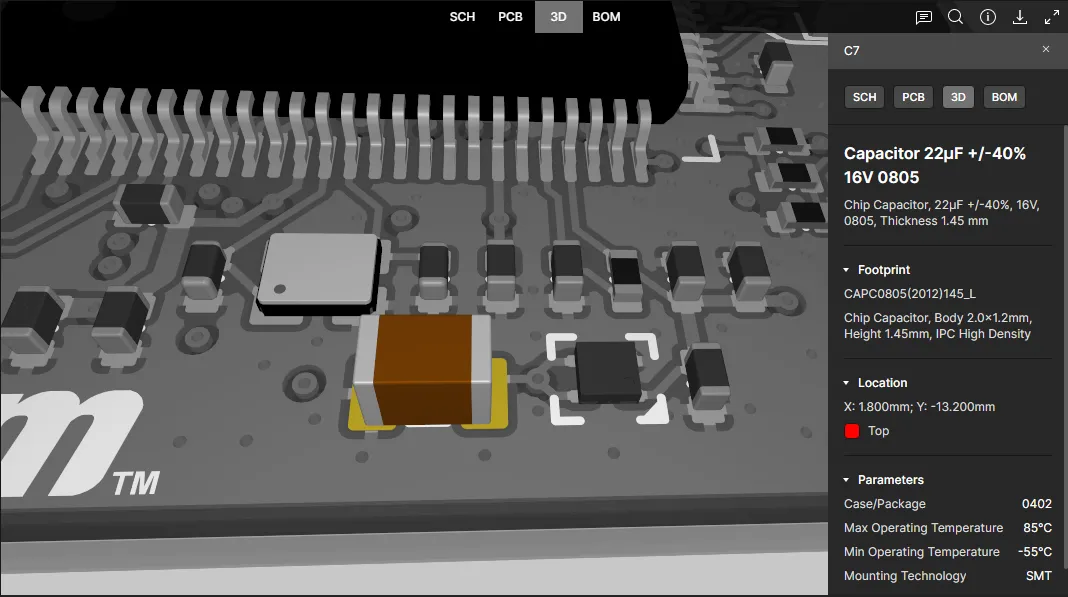
An example of component selected in the 3D data view.
Controls at the top of the right-hand pane enable you to quickly view a selection within another data view, where supported. For example, selecting a component in one data view can be seen in any of the other data views. Selecting a net in the
SCH data view will allow that net to be inspected in the
PCB and
3D data views also. And for a selected pad, via, or track segment within the
PCB data view, you'll be able to quickly view that object within the
3D data view. For more information on this cross-probing support, see
Cross-probing.
Nets Selection
Expand the Nets section in the Projects pane to access a list of nets available in the project design. Select an entry in the list to locate and highlight that net in the Schematic, PCB and 3D views, and also present its details in the right-hand information pane. The latter includes a list of Layers the net occupies, and a selectable list of Schematic documents that include that net.
❯ ❮
Javascript ID: AES_NetsSelection_7_0
|
Select a net entry in the Nets list to visually highlight it in the main design views and also expose its details in the right-hand pane.
Select a net entry in the Nets list to visually highlight it in the main design views and also expose its details in the right-hand pane.
|
Note that selection of net entries is effectively bidirectional, so when a net is directly selected in either the Schematic or PCB view it also will be selected in the Project pane's Nets list.
To inspect a selected net in all compatible views, choose the SCH, PCB, or 3D options from the upper tabs or from the view tab options available in the Net information pane on the right.
❯ ❮
Javascript ID: AES_NetsSelection_Views_7_0
|
Cross-probing
When you select a supported object within the active data view, that object is selected (where applicable) on one or more other data views as well – enabling you to quickly cross-probe to that same selection. Cross-probing support is delivered through button controls located at the top of the right-hand pane – displayed when an object is currently selected in the main viewing window.
You can also click on an upper tab for a data view directly to see the result of cross-probing.
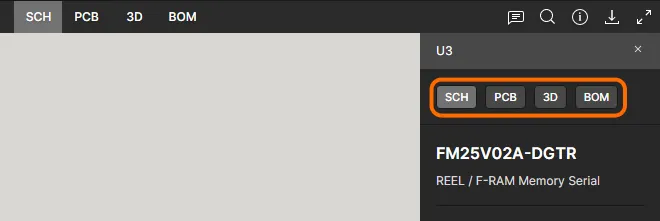 Cross-probing controls (for a selected component).
Cross-probing controls (for a selected component).
The following are a few examples of supported cross-probing scenarios:
-
Cross-probing a Component from the SCH/PCB/3D Data View – select the required component in the active data view, then click one of the buttons to cross-probe to that component in the target data view. For SCH, PCB and 3D data views (accessed by clicking the
 ,
,  , or
, or  buttons), the component will be selected, centered and zoomed within the view where possible, and masking applied to leave only the selected component fully visible.
buttons), the component will be selected, centered and zoomed within the view where possible, and masking applied to leave only the selected component fully visible.
For the BOM data view (accessed by clicking the  button), the entry for the component will be scrolled to the center of the view (where possible) and the row highlighted.
button), the entry for the component will be scrolled to the center of the view (where possible) and the row highlighted.
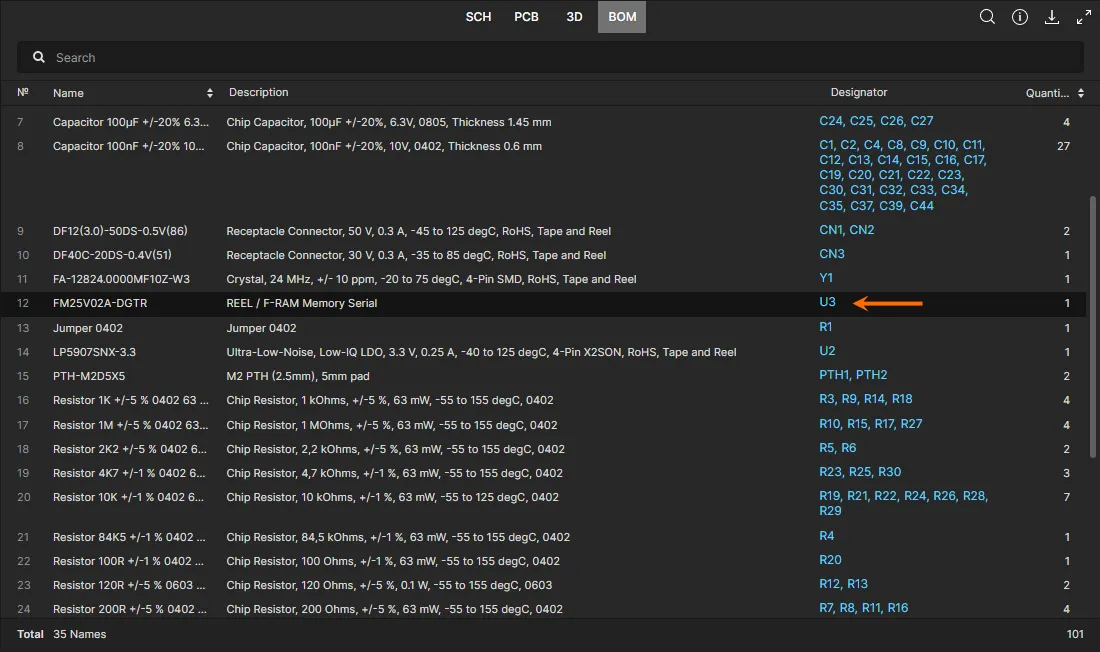
-
Cross-probing a Component from the BOM Data View – click on the designator for the component you wish to cross-probe to. The last active data view prior to accessing the BOM data view will be made active, with the component selected, centered and zoomed within the view where possible, and masking applied to leave only the selected component fully visible. From there, you can use the buttons (
 ,
,  ,
,  and
and  ) to cross-probe to that selected component in other data views as described previously.
) to cross-probe to that selected component in other data views as described previously.
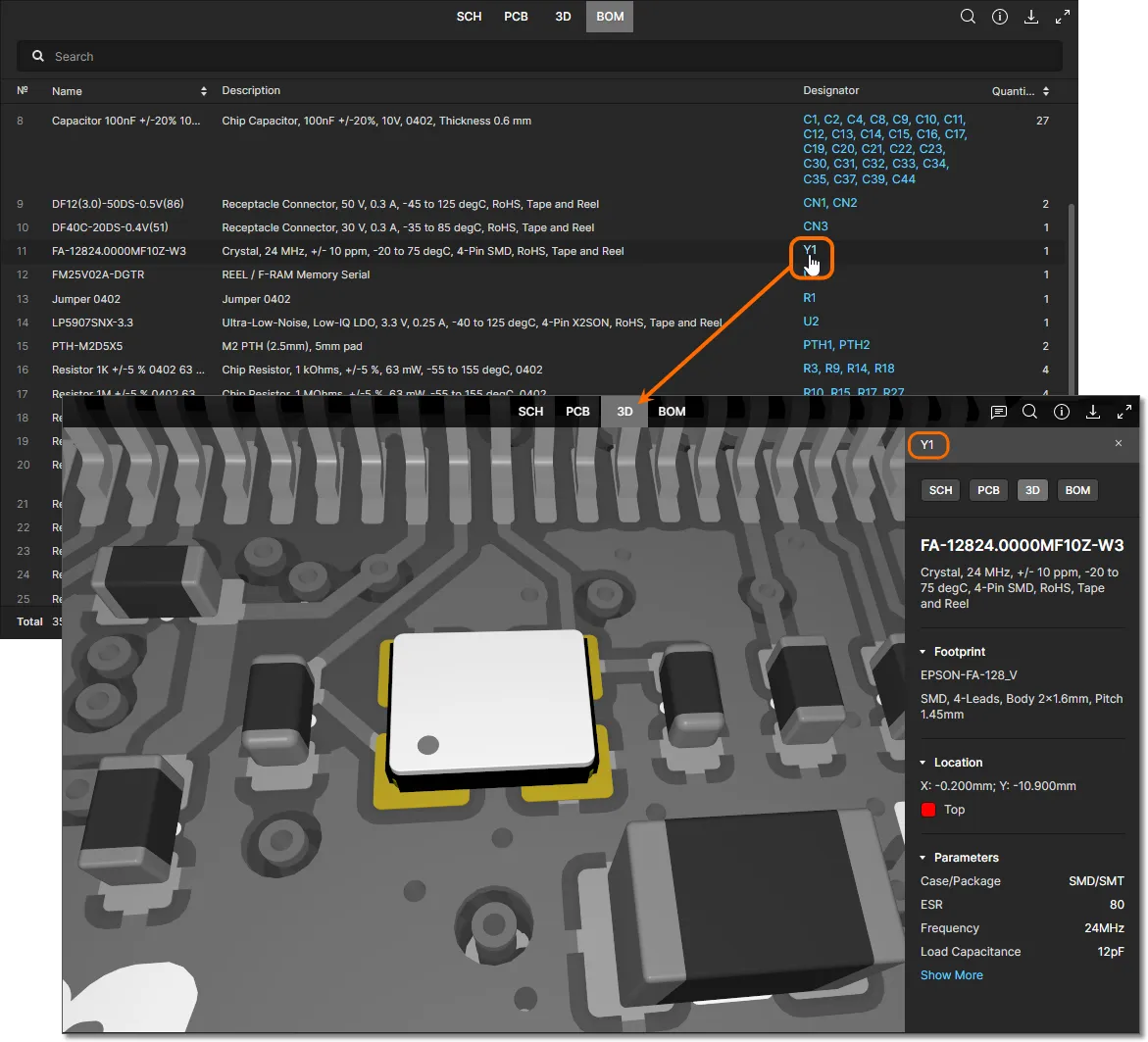
-
Cross-probing a Net from the SCH Data View – select the required net in the Nets navigation list (left) or on the schematic document within the SCH data view , then click one of the buttons (
 ,
,  ) to cross-probe to that net in the target data view. The net will be selected, centered and zoomed within the view where possible, and masking applied to leave only the selected net fully visible.
) to cross-probe to that net in the target data view. The net will be selected, centered and zoomed within the view where possible, and masking applied to leave only the selected net fully visible.
❯ ❮
Javascript ID: AES_CrossProbeNetExSeq_7_0.png
|
-
Cross-probing a Pad/Via/Track from the PCB Data View – select the required pad, via, or track segment on the board within the PCB data view, then click the
 button to cross-probe to that pad/via/track segment in the 3D data view. The object will be selected, centered and zoomed within the view where possible, and masking applied to leave only the selected object fully visible.
button to cross-probe to that pad/via/track segment in the 3D data view. The object will be selected, centered and zoomed within the view where possible, and masking applied to leave only the selected object fully visible.
The associated parent net for a selected pad/via/track object is available as a Net Name link in the right-hand pane. Click this link to select the complete net in the SCH, PCB and 3D views.
Searching
The Web Viewer interface incorporates a search facility that provides a quick and convenient way to locate components and nets throughout your design. The search feature can be accessed from the SCH, PCB and 3D data views by clicking the  button at the top-right of the view, which will open the Search pane.
button at the top-right of the view, which will open the Search pane.
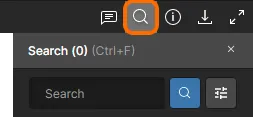 The Web Viewer interface's Search pane.
The Web Viewer interface's Search pane.
To perform a search, start typing your search string. Search is case-insensitive. The pane lists the matching results dynamically as you type. The number of matching results is highlighted at the top of the pane.
Each time the
Search pane is freshly opened, the initial search will contain a subset of the full results (if too many). This is indicated by the text
and x more press Enter at the bottom of the list. To fully expand the results list, either click the

button, or press
Enter (with the cursor in the search field).
 Example search conducted from the SCH data view.
Example search conducted from the SCH data view.
Results are local to the active data view. When the active data view is SCH, as above, the search is across all source schematic documents.
Click the  button to access filter options, to show all components and nets matching the search string, or just components, or just nets.
button to access filter options, to show all components and nets matching the search string, or just components, or just nets.
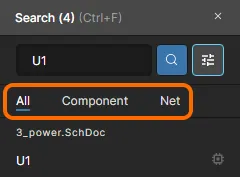 Filter controls.
Filter controls.
The five most recent searches are listed in the Recent Search region of the pane. An entry to the list is only registered once a search result is clicked upon.
With search results listed, click an entry to navigate to that entity – component or net – within the active data view. The component/net will be selected, centered and zoomed within the view where possible, and masking applied to leave only the selected component/net fully visible.
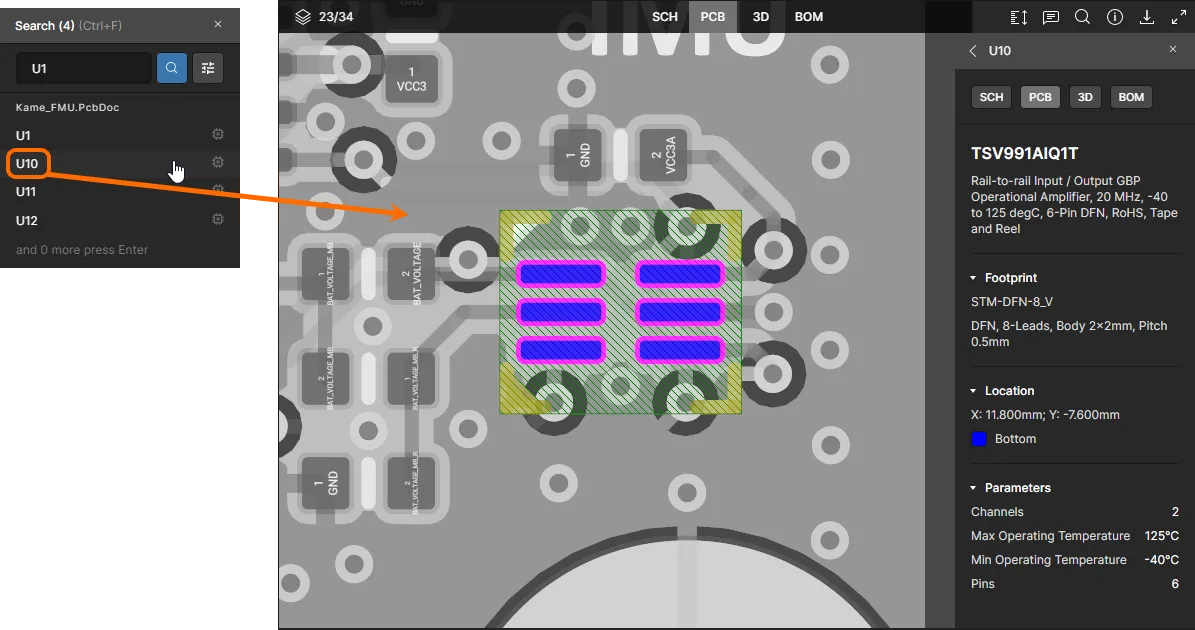 Shown here is the result of searching for a component within the active PCB data view, and also searching for a net within the active SCH data view.
Shown here is the result of searching for a component within the active PCB data view, and also searching for a net within the active SCH data view.
When the searched component/net is selected as above, cross-probing naturally becomes available since that component/net is selected across all relevant data views. For more information, refer back to the section on
Cross-probing.
Downloading
When viewing a design project source, the Web Viewer supports data downloading of data via the Download pane accessed by clicking the  control (located in the top-right control cluster).
control (located in the top-right control cluster).
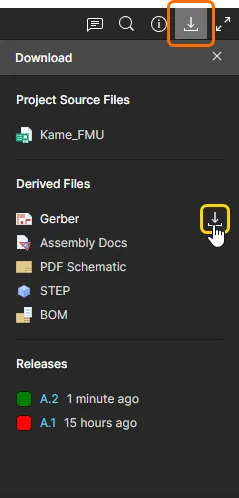
Support is provided for downloading a Zip archive containing a snapshot of the WIP design project (base design), as well as the ability to generate and download the following derived outputs, taking setup information directly from the applicable Output Job file (where one exists):
-
A Zip archive containing Gerber and NC Drill files (generated for the base design only).
If an Output Job file does not exist, a default set of Gerbers (Gerber X2) will be generated for the used layers only (no mechanical layers). For NC Drill, only the *.txt format file will be generated.
-
Either a PDF of the full Draftsman-sourced documentation, which requires the Draftsman document to be present in the project (generated for the base design only – not for variants), or a PDF of just the Assembly drawings (generated for the active variant).
-
A PDF of the schematic documents (generated for the active variant).
-
A 3D STEP file (
*.step) of the board assembly (generated for the active variant).
-
A CSV-format BOM (generated for the active variant).
When generating the BOM, the setup in any Output Job file will be taken and a CSV-format BOM is generated only, as this format is supported by most operating systems without having to worry about configuration and templates. Where an Output Job file does not exist, default fields for the CSV are used as follows: line number (if a BomDoc is available), name, description, designator, quantity, manufacturer and part number.
For generated output based on the active variant (as indicated in the listing above), choose the required variant from the Design – Variants region within the left-hand navigation pane.
Hover over an entry on the pane and click the associated  control to download. Data will be generated first, where applicable, and then downloaded. For output that needs to be generated first, you can either wait or close the Download pane – you'll be able to access the download through an email, which will be sent to you once the data is ready.
control to download. Data will be generated first, where applicable, and then downloaded. For output that needs to be generated first, you can either wait or close the Download pane – you'll be able to access the download through an email, which will be sent to you once the data is ready.
The Releases region of the pane is only presented when viewing the Design Project Source (not a Shared Live Design). All release packages that have been generated from the project will be listed – click an entry to open it for inspection, on a separate browser tab.
Download is to your Web browser's default downloads folder.
Comments
The Web Viewer interface supports commenting of your design documents. A comment is a user-added note that is assigned to a specific point, object, or area (as applicable) on a supported data view, and may be replied to by other users. Comments promote collaboration between users without altering the shared data itself, because comments are stored by the Workspace independently of that data. Comments are posted, replied to, and managed directly within the main viewing area using a contextual commenting window. Comments are also presented on the Comments and Tasks pane, which is presented on the right-hand side and provides more of an overview/navigational instrument, rather than the operational interface.
Use the

control to toggle the display of the
Comments and Tasks pane.
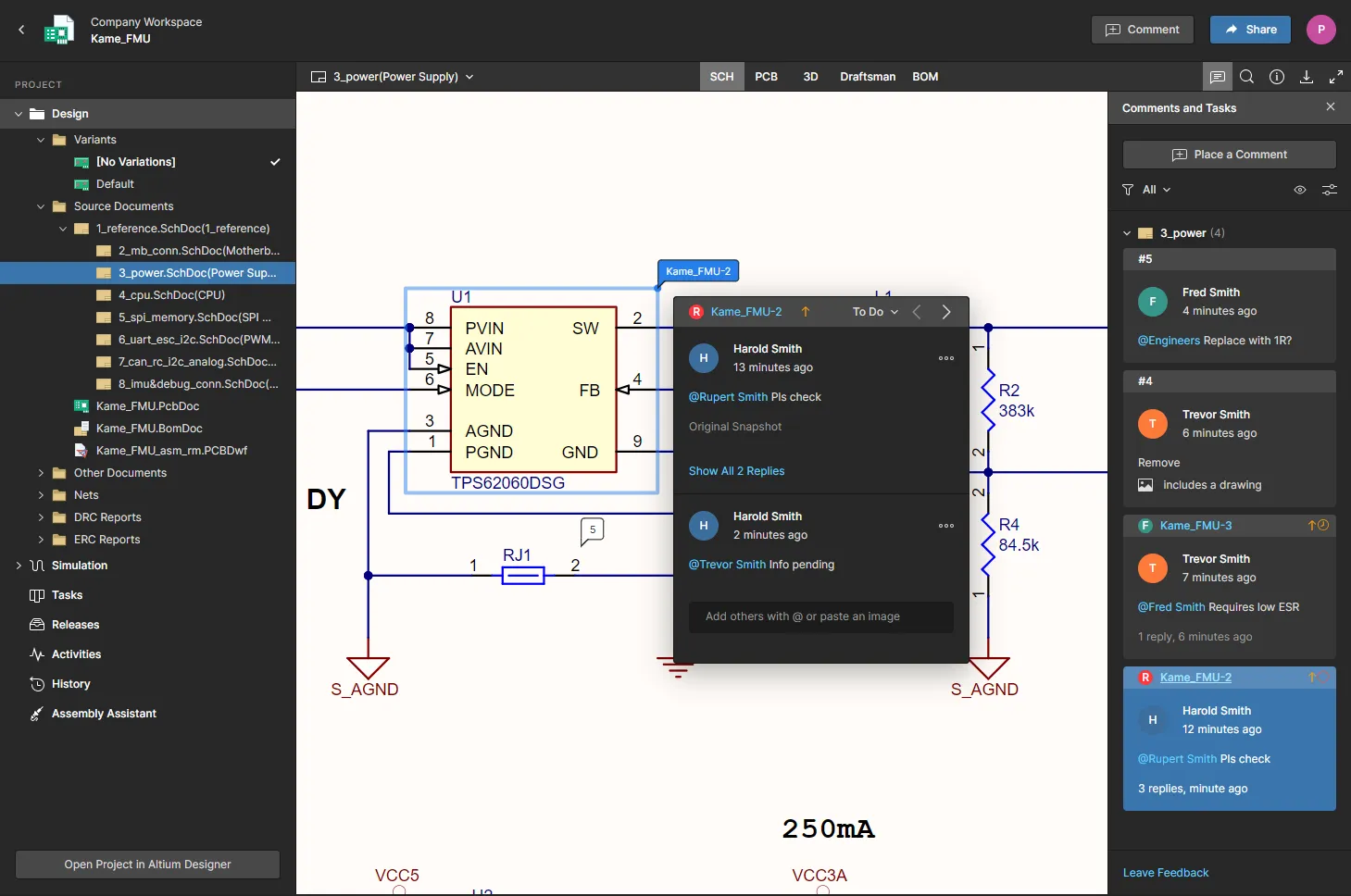
Example comments overlayed on a child schematic sheet of a Workspace project. The Comments and Tasks pane reflects all comments, while the accessible window in the main viewing area brings contextual commenting, right at the place you need it.
The commenting functionality is used in the following places:
-
In the Design view of the detailed management page, when accessing a specific project. Comments can be added to the SCH, PCB/3D, Draftsman and BOM data views. Comments made here appear automatically in Altium Designer and vice versa.
-
In the Design Snapshot view of the Manufacturing Portal, for the chosen release package of the Workspace project actively being inspected. Comments can be added to the SCH, PCB/3D, Draftsman, and BOM data views. Comments made here appear automatically in the Design view of the detailed management page for the project and in Altium Designer.
-
In the Design view of an opened Multi-board project when viewing the top level Schematic (MBS) document. Comments made here appear automatically in Altium Designer, and vice versa.
-
In the Gerber or ODB++ Viewer when viewing an uploaded Gerber/ODB++ fileset.
-
In the Layer Stackup view, which is available from the Design view of the detailed management page when accessing a specific project and the Design Snapshot view of a project Release. Comments made within the Web Viewer are seen by stakeholders with whom the manufacturing package has been shared, and those who are using the Viewer to inspect that package. The comments are not shared with the Layer Stack Manager in Altium Designer.
Placing a Comment
Comment placement mode can be entered in one of three ways:
The first two methods enable you to add comments without losing the current selection in the active data view and without closing any existing right-hand pane that you might already have open (e.g. Information pane presenting properties for the currently selected object, Measurements pane presenting taken measurements, Download pane, Board Info, etc).
In each case, the cursor will change to a cross-hair and you will enter comment placement mode. Proceed as follows:
-
Place one of the following three supported comment types as required:
-
Comment on a point – click at any point to attach (or 'pin') a comment to that point. A line entry is selected when commenting in a BOM document.
-
Comment on object – as you move the cursor around the view, supported objects to which you can attach a comment to will be highlighted. For the SCH data view supported objects are components, pins, wires, busses, and ports. For the PCB data view, supported objects are components, pads, vias and track segments. For the 3D data view, supported objects are components, pads and vias. For the SCH and PCB data views, supported objects to which you can attach a comment to will be highlighted as you move the cursor around the view. This type of comment is not supported in the Draftsman view, or Gerber view when viewing Gerber data.
-
Comment on area – click and drag to define an area to attach (or 'pin') the comment to. This type of comment is not supported in the 3D data view.
-
In each case a commenting window will be presented, with which to define the comment in context with the chosen point, object, or area (as applicable). Type your comment in the field provided. You can mention one or more users or groups in the comment. Type the @ character in the comment field to quickly access a list of Workspace users. A comment also can be assigned to a user. For more information on these additional features, see the section Working with the Contextual Commenting Window.
-
With a comment entered, any mentions added, and assignments made if required, click the
 button beneath. The comment will be committed, appearing in both the contextual commenting window and the Comments and Tasks pane. A uniquely numbered marker for the comment will be shown in the main design viewing area.
button beneath. The comment will be committed, appearing in both the contextual commenting window and the Comments and Tasks pane. A uniquely numbered marker for the comment will be shown in the main design viewing area.
Comment markers are unique to a project and are issued sequentially as comments are placed across that project. Comments placed on the PCB data view are reflected on the 3D data view and vice versa (for point and object comment types only). The same comment marker number is therefore used between these two views.
At any point before posting you can exit comment placement mode by pressing Esc.
The following sequence image shows the addition of an example comment to a component on a schematic document (within the SCH data view), along with adding a mention of a user and assigning a Task to them (see below for details).
❯ ❮
Javascript ID: AES_Comments_PlaceCommentSeq_7_0
|
Comments placed on a PCB when viewing in 2D mode are associated with current Layer view – the visible and active layer settings when the comment is placed. The comment's Layer view settings are restored when it is subsequently selected in the Comments and Tasks pane or from its marker in the PCB view.
❯ ❮
Javascript ID: AES_Comments_LayerSpecific_7_0
|
|
|
The commenting system will automatically detect that a Workspace member you have mentioned in a comment does not have access to the current design project, and then offer to share the project with them – as shown in the below image sequence. In this case a Share window will appear where you can specify if the project is shared with only viewing rights or full editing permissions (View/Edit). Confirm sharing of the current project with the  button. Note that you can use the Copy Link option to obtain a URL link to the current project comment.
button. Note that you can use the Copy Link option to obtain a URL link to the current project comment.
❯ ❮
Javascript ID: AES_CommentsMentionShare_7_0
|
-
Comments applied in the Web Viewer interface in the Design view of the detailed management page (when managing a specific project) become available in Altium Designer and vice-versa, and all changes to comments are reflected in both places.
-
Comments made in the Design Snapshot view when viewing a specific release of a project (through the Manufacturing Portal) also become available in the Design view of the detailed management page for the project and in Altium Designer, but not the other way around.
-
In Altium Designer, the Comments and Tasks panel is command-central for comments. For a high-level run-through of working with comments in relation to a Workspace project in Altium Designer, see Document Commenting.
Working with the Contextual Commenting Window
The following points relate to working with comments and the interface's contextual commenting window:
-
The commenting window is accessible independently of the Comments and Tasks pane – click on a comment marker to access it.
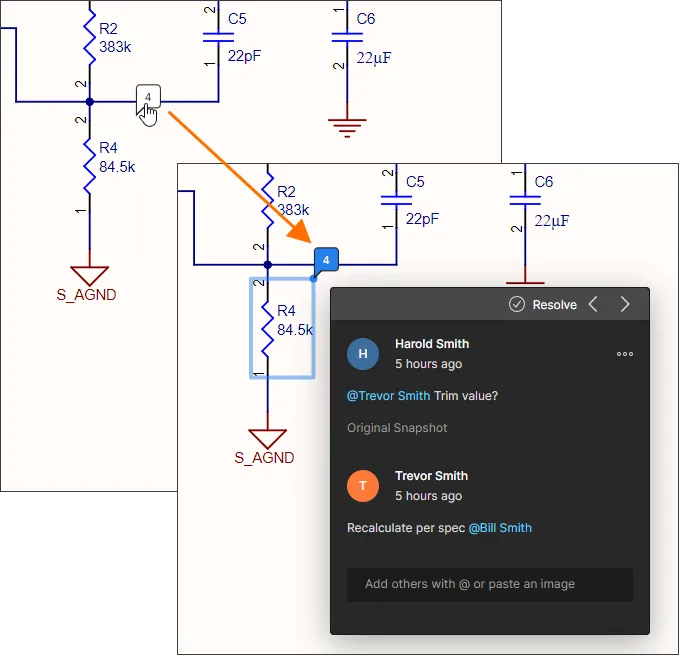
If the comment marker is moved, the commenting window will move also. The window can be moved freely by itself as well.
-
Use the  buttons at the top-right of the commenting window to sequentially cycle to the previous and next comments respectively. Cycling is based on the numbering of the comment markers and will simply zoom and center the point, object, or area (as applicable) of the design that the previous/next comment is associated to, and present that comment in the commenting window.
buttons at the top-right of the commenting window to sequentially cycle to the previous and next comments respectively. Cycling is based on the numbering of the comment markers and will simply zoom and center the point, object, or area (as applicable) of the design that the previous/next comment is associated to, and present that comment in the commenting window.
You can also use the Shift+Left Arrow and Shift+Right Arrow to cycle to the previous and next comments respectively.
-
Once an initial comment has been made the commenting window, when accessed, will be ready for entry of a reply. Type your text in the field provided, then click the
 button to commit. To exit without replying, click the
button to commit. To exit without replying, click the  button.
button.
-
You can mention a user or group within a comment. Enter the @ character to access a pop-up listing of all Workspace users and groups. Alternatively, search for the role or user (the latter by their name or email). The @ character can be followed by one or more characters to open a filtered list of matching users and groups from which to choose.
❯ ❮
Javascript ID: AES_Comments_MentionSeq_7_0
|
|
|
-
You can assign a task to a user who has been mentioned. Enable the Assign a task to option accordingly – this defaults to the first-mentioned person, or if no mention is included, to yourself (Me). Alternatively, use the drop-down menu to choose a different Workspace user to assign the task to. The assigned user is shown in the Comments and Tasks pane entry as their user profile image/letter, with an associated task reference. The task assignment can be changed or removed when editing the comment.

Where a task is associated with a comment its window upper border includes:
-
an icon (image/letter) indicating the member that has been assigned to the comment's task. Select the icon to reassign the task to a different Workspace user from the drop-down list.
-
the task's alphanumeric reference, composed of the project ID/Name with a task number suffix. Click on the reference to cross-probe to that task entry in the Workspace Tasks page for the project.
-
a task priority icon (arrow/flame), which is
Medium by default and may be changed from the task's entry in the Workspace Tasks page.
-
the task's current activity status (
To Do, In Progress, Resolved), which can be changed from the associated drop-down menu.
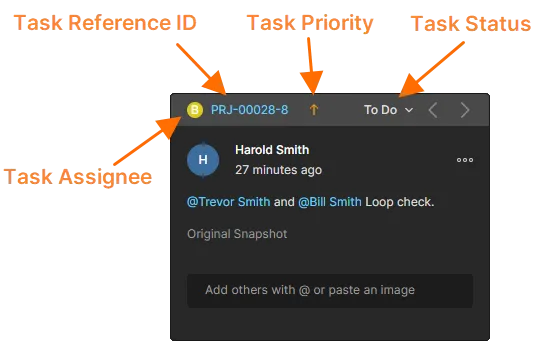
Along with the Tasks page that applies to a specific project, the Workspace also offers a global Tasks page view that is populated with all tasks that are currently active in the Workspace. The former, which you cross-probe to when selecting a Task reference ID, includes Tasks arranged by project documents, whereas the latter includes Tasks arranged by Workspace projects.
See information on the Tasks page for a specific project.
See information on the Tasks page for all Workspace projects.
See information on comment Task assignment in Altium Designer's Comments and Tasks panel.
-
A task can be added to an existing comment using the Convert to Task option available from the window's  menu. The new task initially is assigned to you, and can be changed to another Workspace member by selecting their entry from the drop-down list opened from the assignee avatar (top left). Note that the marker in the document view will change from a simple comment reference number to the Task ID.
menu. The new task initially is assigned to you, and can be changed to another Workspace member by selecting their entry from the drop-down list opened from the assignee avatar (top left). Note that the marker in the document view will change from a simple comment reference number to the Task ID.

-
When adding a new comment or editing an existing one, you have the opportunity to add a freehand drawing to the design view and associate/attach it to that comment. To do so, click the  button above the commenting window. You will enter freehand drawing mode and the commenting window will be temporarily replaced with a floating control bar. Note that you can switch back to the 'comment' mode at any time by clicking the
button above the commenting window. You will enter freehand drawing mode and the commenting window will be temporarily replaced with a floating control bar. Note that you can switch back to the 'comment' mode at any time by clicking the  button. In freehand drawing mode, place the cursor, and then click and drag to build the artwork you require. Buttons on the control bar allow you to change color and width of the drawing line (very useful for the 2D view of the PCB), and if you make a mistake just click
button. In freehand drawing mode, place the cursor, and then click and drag to build the artwork you require. Buttons on the control bar allow you to change color and width of the drawing line (very useful for the 2D view of the PCB), and if you make a mistake just click  to delete the drawing and start again. The comment can also be posted (
to delete the drawing and start again. The comment can also be posted ( ) or canceled (
) or canceled ( ) from the control bar using the buttons at the far right.
) from the control bar using the buttons at the far right.
❯ ❮
Javascript ID: AES_Comments_FreehandDrawingSeq_7_0
|
-
The commenting window will also accept an image file or captured screenshot pasted from the Windows clipboard. You can paste the screenshot (or copied image file) into the comment field before or after any text notes and user mentions. The image graphics are diplayed in the body of the commenting window – click on the image to open it for viewing at full-size. The placed comment's entry in the Comment and Tasks pane will include a related Includes Images note.
❯ ❮
Javascript ID: AES_Comments_PasteImage_7_0
|
-
When a new comment is posted, a screenshot of the original view is taken and attached to that comment. From within the commenting window, this can be accessed by clicking the Original Snapshot control. The snapshot presents exactly what was seen in the view at the time of comment creation – so the same zoom level, active layers (PCB), and also includes the freehand drawing if one was created prior to posting the comment.
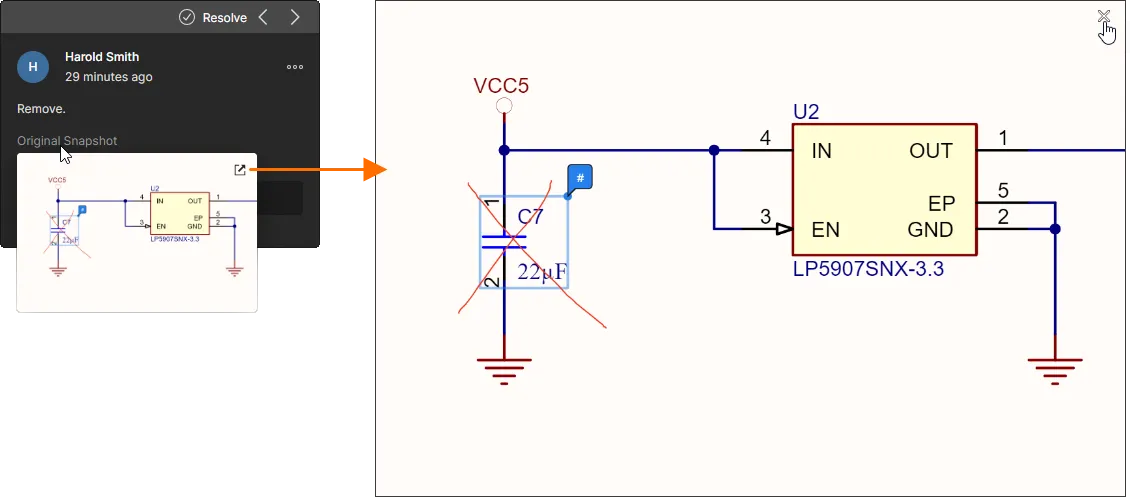
Click the

control at the top-right corner of the screenshot to access its full-size view. Click away from the view to return to the commenting window.
-
A comment can be edited or deleted, through the commenting window only, using the Edit and Delete commands from the
 menu. Note that these commands will only be available for a comment that you yourself have made – you cannot edit or remove a comment made by another user. If you edit an existing comment, make your changes then click the
menu. Note that these commands will only be available for a comment that you yourself have made – you cannot edit or remove a comment made by another user. If you edit an existing comment, make your changes then click the  button to commit. To exit without applying any changes, click the
button to commit. To exit without applying any changes, click the  button.
button.
If you delete a comment, be aware that all associated replies also will be deleted.
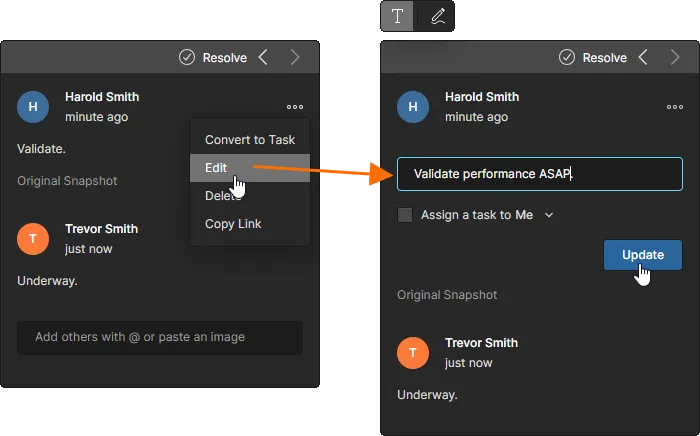
Editing a comment you have made allows you to change the comment, mentions, assignment, or add a freehand drawing (where supported).
-
The menu associated with the
 menu also includes a Copy Link command. This allows the original creator of the comment thread to obtain and share a link for viewing the entity.
menu also includes a Copy Link command. This allows the original creator of the comment thread to obtain and share a link for viewing the entity.
-
When the commenting window is accessed (by clicking on its associated marker, or by selection on the Comments and Tasks pane) only the initial and latest comments in the thread are presented. To see all comments in the thread, click on the available control between these entries. Use the scrollbar to browse through all comments.
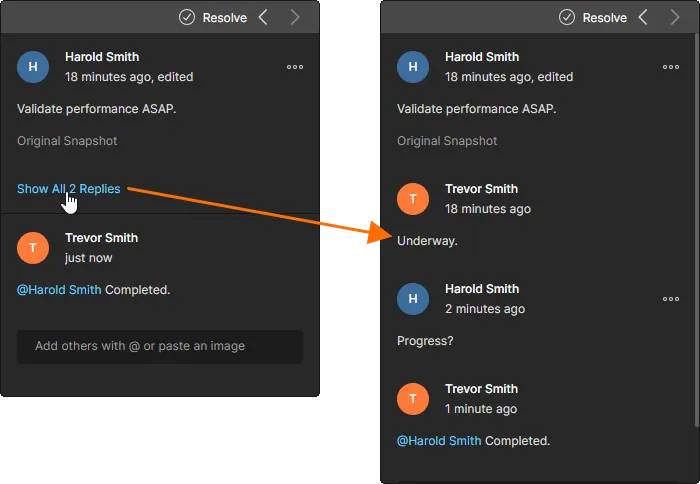
-
Anybody viewing the shared design project can resolve a comment (or make it active again) by toggling the
 control at the top of the commenting window. Where the comment has an assigned Task, its current status can be changed to Resolved (or another level) from the status drop-down menu. Resolved comments are not shown in the Comments and Tasks pane by default, but can be exposed through its show/hide pins option – see the next section for more information.
control at the top of the commenting window. Where the comment has an assigned Task, its current status can be changed to Resolved (or another level) from the status drop-down menu. Resolved comments are not shown in the Comments and Tasks pane by default, but can be exposed through its show/hide pins option – see the next section for more information.
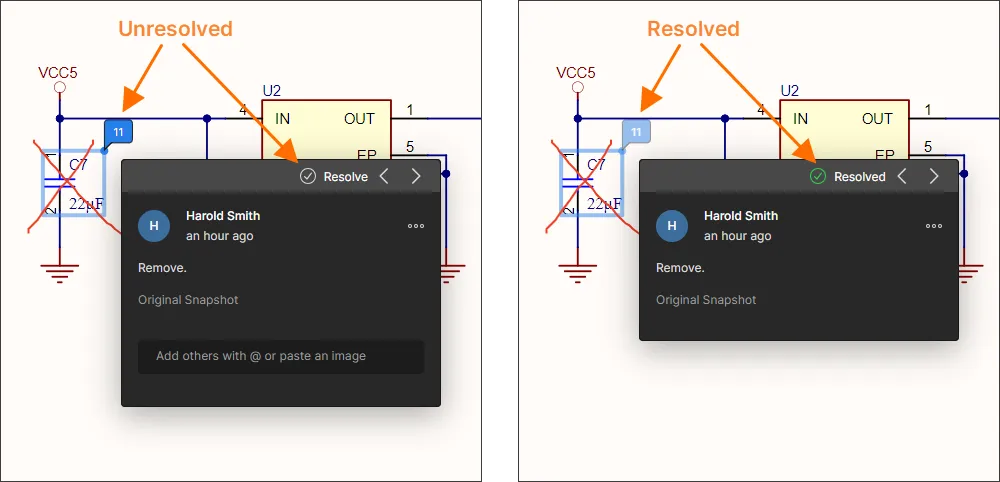
-
If a previously committed project (shown as a Commit event in the History view) has a VCS Tag attached, then its comments will be shown with the tag name included – this acts as a link to that specific commit snapshot.
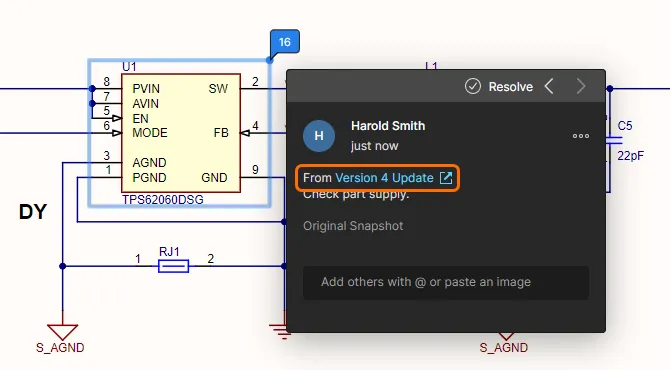
-
If a person has made a comment while reviewing a specific release of a design project (in the Design Snapshot view of the Manufacturing Portal), then that comment will include the release information as a link to that release.
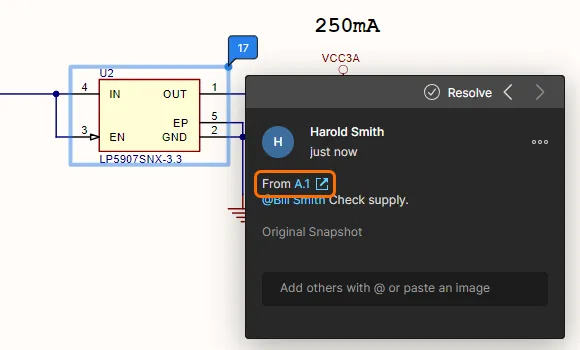
-
You can add a URL link as part of your comment post – just copy the URL and paste it into the comment field. It will be detected and presented as a standard link that can be followed when clicked.
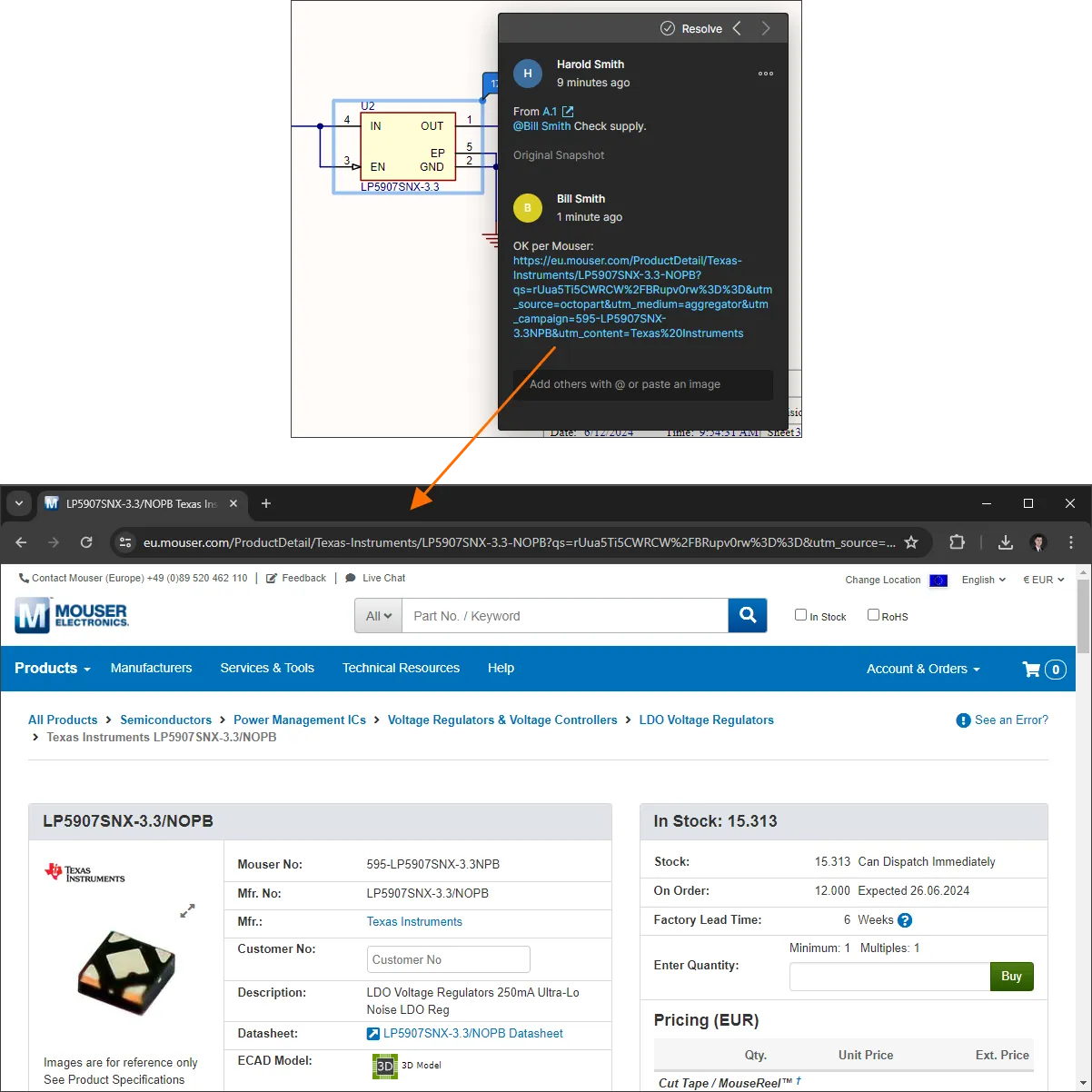
Working with the Comments and Task Pane
The following points relate to working with comments and the interface's Comments and Tasks pane:
-
The Comments and Tasks pane facilitates an overview/navigational tool for comments across the project, rather than the operational interface of posting, editing and replying. That functionality is solely left to the contextual commenting window.
-
The Comments and Tasks pane does not open upon clicking a comment marker in the main viewing area. The latter accesses the contextual commenting window only.
-
Use the control at the top-left of the pane to display comment marker pins within the main viewing window ( ), or to hide them (
), or to hide them ( ). Hover over the image to see an example.
). Hover over the image to see an example.
❯ ❮
Javascript ID: AES_CommentsPane_ShowHideCommentsEx_7_0
|
-
At the top of the Comments and Tasks pane are controls that provide access to thread filtering controls, so that you can determine what is presented in the pane. Two levels of filtering can essentially be defined. The first, or primary level allows you to control which user comments are displayed.
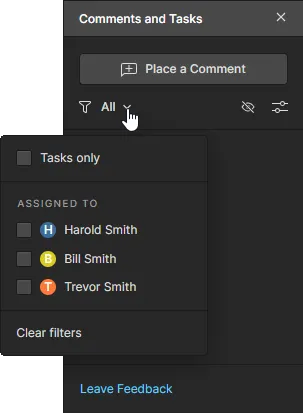
The pane's filter options constrain the comment entries to:
-
Tasks only – only those comments that have been assigned as user tasks, which are, in turn, available in the Tasks page flow.
-
ASSIGNED TO – only comments that are assigned to the user selections listed below. When a user checkbox is selected, the pane (and displayed document) will include only those comments that have tasks assigned to that user.
The secondary level of filtering, which is applied in conjunction with the primary filtering method offers two options, allowing you to hide all resolved comment threads (Unresolved only enabled) and/or to only show comments for the active document being viewed, rather than the entire project (Current document only enabled).
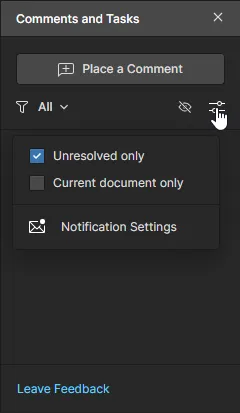
-
Click the Notification Settings entry (at the bottom of the above options window) to access a window with which to configure which comments in the project you will receive email notifications for. Choose to receive notifications for all comment threads, no comment threads, or only those you are involved in (you started, replied to, or have been mentioned within).
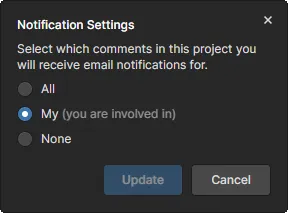
-
In terms of ordering of comment threads in the pane, again there are two levels. Firstly, comments are ordered by the document they are on, and this follows the same ordering as the source document navigation structure in the left-hand pane. Secondly, for each document, the comments are ordered by the date of their creation – in descending order.
-
As you click on a comment thread entry in the pane, that comment will be focused in the main viewing window, and opened in the contextual commenting window. The entry for the comment in the Comments and Tasks pane is also highlighted in blue. The same comment marker number is reflected in the Comments and Tasks pane, making it easy to see which comment you are viewing. If you click on a comment that doesn't reside on the document currently being viewed, then that document of residence will be made the active document.
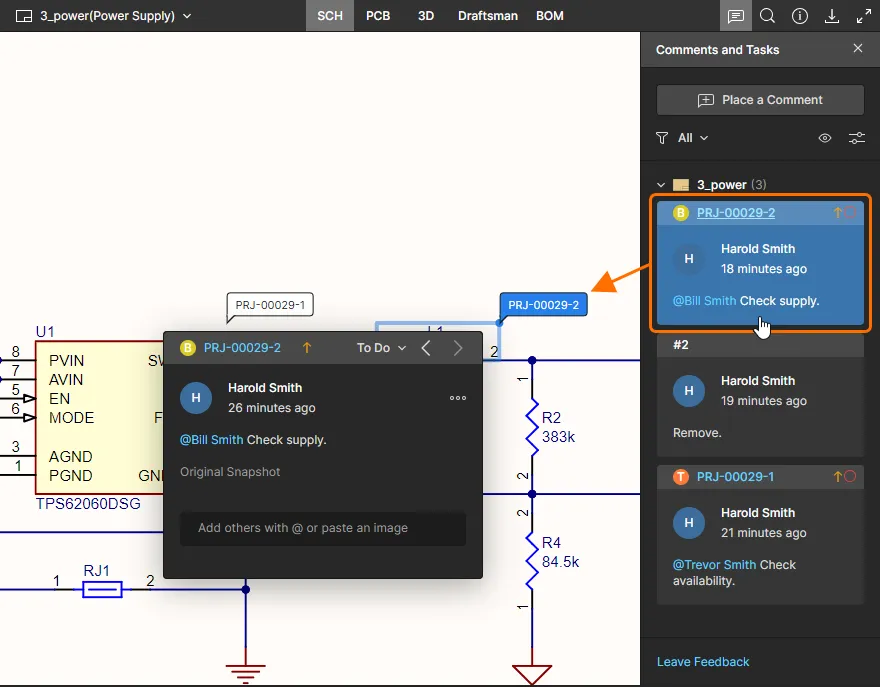
-
Each comment entry in the pane provides a useful summary of key information relating to that comment, as shown in the example below.
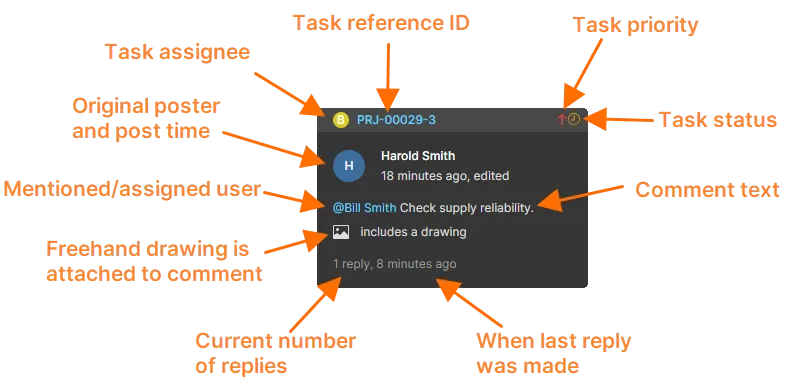
-
If a person has made a comment while reviewing a previously committed project (shown as a Commit event in the History view) that has a VCS Tag attached, then that comment will include the tag name as a link to that specific commit snapshot, as shown above.
-
If a person has made a comment while reviewing a specific release of a design project (in the Design Snapshot view of the Manufacturing Portal), then that comment entry will include the release ID as a link to that specific release, as shown above.
Other Things to be Aware of
-
If a comment is associated with an object and that object gets removed from the design, then the comment will be converted to an area comment and remain at the same coordinates. The comments' original design screenshot can prove very useful in this respect.
-
If a design document is removed from the project, any comments associated to that document will be hidden.
-
If an object is moved within the design, the comment associated to it will also move.
-
For designs that made use of freehand comments in previous versions of Altium Designer, those will be converted to area comments, and the freehand drawing attached to the comment in each case.
-
Altium Designer 20.x will ignore line color and width settings used in the freehand drawings. Instead, such drawings will appear using red colored lines only and using the standard, non-adjustable line width available for comments in earlier versions of the software.
-
A resolved comment cannot be deleted. You would need to make it unresolved and then delete.
Updating with New Data
When using the Web Viewer interface to inspect the documents of the latest source project – from the Design view of the Projects Management page (when managing a specific project) – the data will update automatically whenever the project is committed back to the Workspace (from Altium Designer). Notification will appear within the interface shortly after the committal.
Note that you can access and work with existing data while the new view data is being generated. Once the new data has been generated, click the Refresh Page control to update the view with that latest data set.
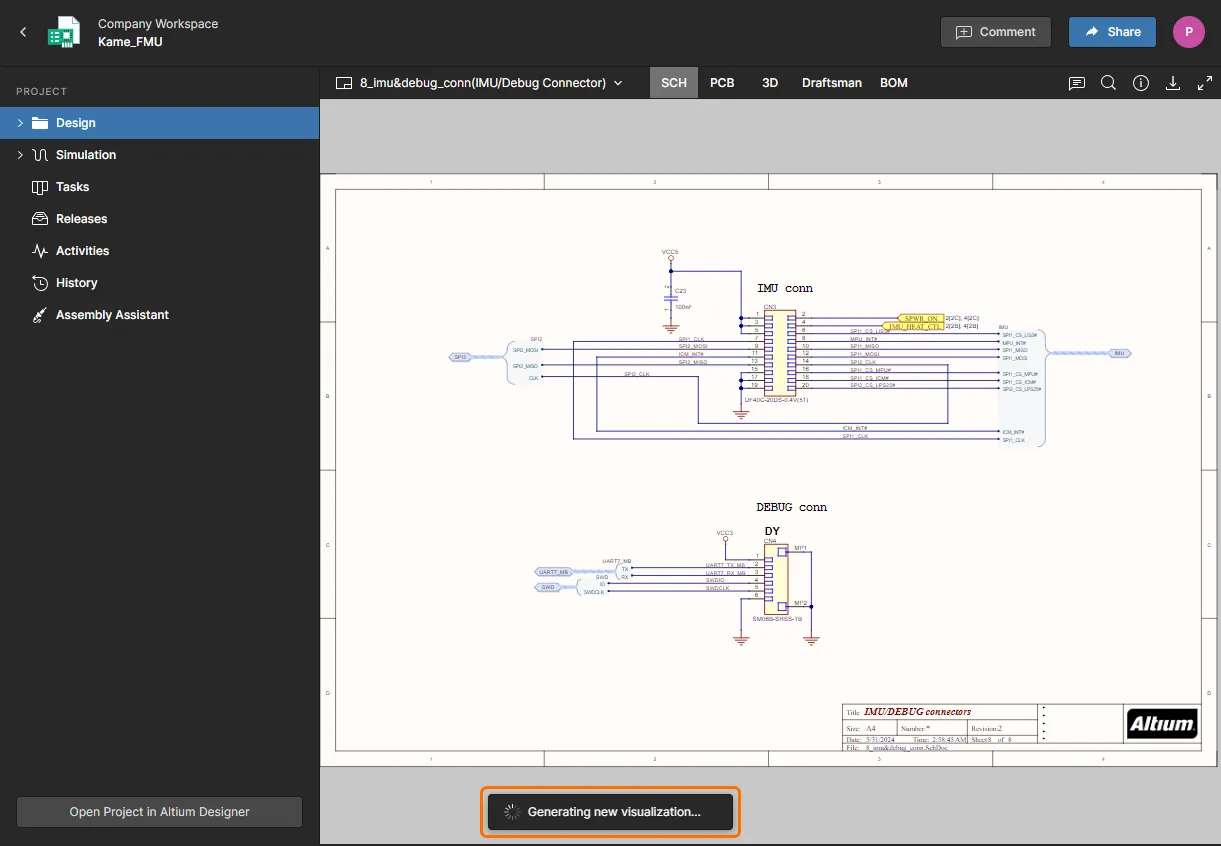
If you make changes to the design and save to the Workspace within Altium Designer then the Web Viewer interface will automatically detect and make the new data available.